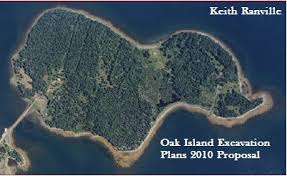
Question. 'Ear' shape?
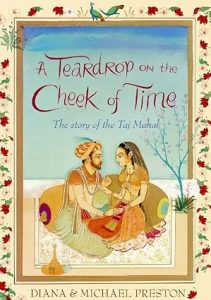 "The 'head' can offer no testament to these things you follow, these 'things' you seek. The tears come to those only who do not yet understand. They are the test of understanding...You think to much in this way...Learn to look more. Shake you head free and look. Look at the source of sound. Look at the ear. If you look at the ear, you will see why there were two doors at Erech. Is the ear an entry or a gauze - a veil? Does it filter or does it block? There is a greater mystery in the 'veil' than is generally realized...For the moment, i can only tell you that the veil which looks like delicate 'white' lace is made of salt." ['The Zelator']. Try ''ear''.
"The 'head' can offer no testament to these things you follow, these 'things' you seek. The tears come to those only who do not yet understand. They are the test of understanding...You think to much in this way...Learn to look more. Shake you head free and look. Look at the source of sound. Look at the ear. If you look at the ear, you will see why there were two doors at Erech. Is the ear an entry or a gauze - a veil? Does it filter or does it block? There is a greater mystery in the 'veil' than is generally realized...For the moment, i can only tell you that the veil which looks like delicate 'white' lace is made of salt." ['The Zelator']. Try ''ear''.
Question. What 'substance' {if any} can be left behind due to the 'evaporation' of water/air by way of a 'fire'. What does {can?} - it represent?
Spirit fire? Therefore ''lace'' = ?
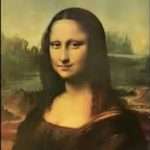
Which one 'wears' the veil or does it matter?
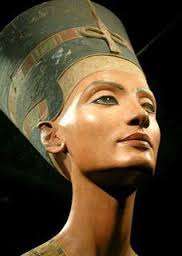 Something to ponder on: "Inspiration is the principle acting in 'tears'. Just like weeping, inspiration takes place in the guise of 'flowing between two vases'. In inspiration, whatever its true source of origin may be, a flow is active, which is produced between the higher Self or image and the lower self or likeness. Here there is a flow which results from the simultaneous collaborations of the "higher eye" {or "ear"} and the "lower eye" {or "lower ear"}. This means to say that higher understanding and lower understanding, being in contact, vibrate in unison, each with its own voice and in terms of its own language, and thus together produce a concrete inspiration." ['Letter 14' within the book 'Meditations on the Tarot'].
Something to ponder on: "Inspiration is the principle acting in 'tears'. Just like weeping, inspiration takes place in the guise of 'flowing between two vases'. In inspiration, whatever its true source of origin may be, a flow is active, which is produced between the higher Self or image and the lower self or likeness. Here there is a flow which results from the simultaneous collaborations of the "higher eye" {or "ear"} and the "lower eye" {or "lower ear"}. This means to say that higher understanding and lower understanding, being in contact, vibrate in unison, each with its own voice and in terms of its own language, and thus together produce a concrete inspiration." ['Letter 14' within the book 'Meditations on the Tarot'].
Question. What substance can be found in 'tears'?
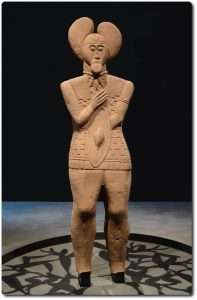
Sing a song of SIXpence and/or Beans in My Ears {Serendipity Singers}. 'Mother Goose' stories. Anything?
Question 2. Recall the 'ear' tablets in the Nile delta {Sais}. Therefore 'lower' ?
Question 3. Where would 'higher' be represented?
A working example?: ''Arthur struch her across the middle until she was two tubs...'' [Page 189 'A Celtic Quest' / J. Layard].
'How to Know Higher Worlds' / R. Steiner.
A working example: "And all the ancient ritual texts say that the star in the Bull's Thigh {'male'?} was sighted simultaneously with the rising of Sirius {'female'?}." [Page 127 'Imhotep the African'. All emphasis, this readers].
Question. Why? What does that simultaneous 'sighting' mean to them? Try the word highlighted to get into a mind set. In the broader sense of the word {'logos'} beyond what this author is attempting, i.e., Alkaid in relation to the Heliacal rising of Sirius.
Then try {among others} ''handle'' / ''Quern'' / ''Sisters'' / ''plough'' etc.
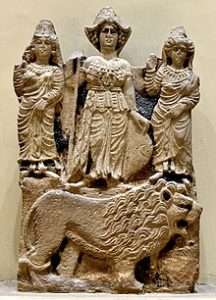
Al-Lat was also called as a daughter of Allah along with the other two chief goddesses al-'Uzza and Manat. According to the Book of Idols, the Quraysh were to chant the following verses as they circumambulated the Kaaba: By al-Lat and al-'Uzza, And Manat, the third idol besides.
REFRESHER: "He who aspires to be a sage and to know the Great Enigma of Nature must be the heir and despoiler of the Sphinx: his the human head, in order to posses speech; his the eagles wings, in order to scale the heights; his the bulls flanks, in order to furrow the depths; his the lions talons, to make a way on the right and the left, before and behind." [Quote taken from the chapter entitled 'The Candidate' from the book by E. Levi].
And/or: ''These 'angels' are described as a composite of Ox, Lion, Eagle and Man. They are the 'Elements' themselves on a higher level, being the Fixed signs of Taurus, Leo, Scorpio, and Aquarius...Strength and Patience for the Ox, courage and nobility with the Lion, swiftness and aspiration with the Eagle, and intelligence and devotion with Man.'' [Page 31 'Ladder of Lights' / W. Gray].
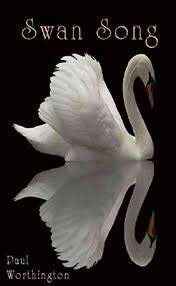
Mirror symmetry? 'Three and four'?
REFRESHER: "The science of the I Ching, indeed, is not based on the causality principle, but on a principle {hitherto unnamed because not met with among us}, which I have tentatively called the 'synchronistic' principle. My occupation with the psychology of the unconscious processes long ago necessitated my casting around for another explanatory principle, because the causality principle seemed to me inadequate for the explanation of certain remarkable phenomena of the unconscious {Wolfgang Pauli?}. Thus I found, that there are psychic parallelisms which cannot be related to each other causally, but which must stand in another sort of CONNECTEDNESS. This connection seemed to me to lie mainly in the relative simultaneity of the events, therefore the expression 'synchronistic'..." [Page 141, The Secret of the Golden Flower / R. Wilhelm WITH a commentary by G. Jung].
Try ''simultaneous'' to see subject material in the universal sense of the 'word' - since the oral tradition BEFORE ''the written word came into common use''.
N....Connection between Neolithic cave drawings and paleolithic ‘bear’ skulls and the zodiac. Especially in relation to the number seven, [explained elsewhere]...and the smaller/greater bear constellation. In relation Micro/Macro within a 'journey' . That link to what later became known as the Precession of the Equinox.
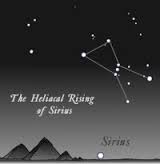 P...Explanation of limbo / Eternal / time differential / resurrection / reincarnation. In relation to the journey of A-C. The connection of the above to T. Lethbridges book on the Pendulum; especially in relation to the differences in ‘time’, in A, B and C. Together with....
P...Explanation of limbo / Eternal / time differential / resurrection / reincarnation. In relation to the journey of A-C. The connection of the above to T. Lethbridges book on the Pendulum; especially in relation to the differences in ‘time’, in A, B and C. Together with....
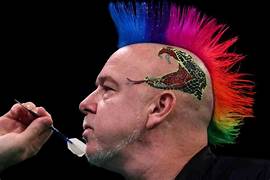
Snakebite.
"The third type of netherworld 'snake' in Egyptian mythology is the symbolic snake. These were sometimes shown as the uraeus on the pharaoh's brow, or seen standing vertically on the tips of their tails. The vertical ones are often called Nehep snakes, from the verb meaning to 'leap' up, which was a euphemism for resurrection, since resurrection was always associated within the Egyptian mind, with the leaping of the resurrected sun over the horizon at dawn." [Chapter eight. 'The Sphinx Mystery'. Mentioned elsewhere]. Think about it in relation to the 'coiled' [sleeping] 'position', i.e.,horizontal. 'Benefits' of, relative to the individual, together with what the word 'leap' is a representational of. That final link to 'Sirius'.
And/or: ''There are perhaps a hundred pendulums moving here and there in man. These ascents and descents, these wave like flunctuations of moods, thoughts, feelings, energy, determination, are periods of the development of forces between 'intervals' in the octaves as well as the intervals themselves...'' [Location 2688 {Kindle}: 'In Search of the Miraculous'].
Apply it to: "But none of these comparatively northern streams suit the stellar position of our Eridanus, for it is a southern constellation, and it would seem that its earthly counterpart ought to be found in a corresponding quarter = the Nile - the only noteworthy river that flows from south - north, as this is said to do when rising above the horizon...Caesius thought our Eridanus was the sky representation of the Jordan, or the Red Sea, which the Israelites passed over - as on dry land." ['Star Names and Their Meaning'].
'The Green Snake and the Beautiful Lily' And/or 'The Tale of the Shipwrecked Sailor'.
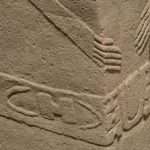
Coincidence or a meaningful one {found at Gobekli-tepe}.
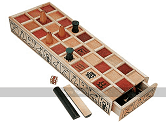
The 'middle' way.
The Tau cross. Some say 'its' true representation. Indicative of 'raised arms'.[Wikipedia], together with Exodus 17:11. "And it came to pass, when Moses held up his hand, that Israel prevailed: and when he let down his hand, Amalek prevailed." Or in its physical 'form' the 'H' structures found at Puma Punku in Bolivia. Or Egyptian equivalent of same = Ka, i.e.,its symbol = 'raised arms/hands', [chapter eight. 'The Sphinx Mystery'].
Question. Any figures at Gobekli-tepe with raised arms?
EAST?
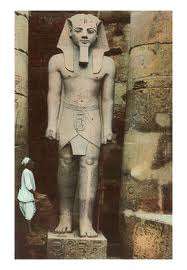
Best foot forward.
Side note: Astrologers assigned this constellation guardianship over human hands, arms, and shoulders...A fortunate sign ruling over among other Lower Egypt...High regard was given to it...as being peculiarly connected with the fortunes of the South of England and London...The Great Plague and the Fire occurred when this sign was in the ascendant, while the building of London bridge and other events of importance to the city were begun when special planets were here." ['Star Names and Their Meaning' under Gemini]. Try ''bridge''.
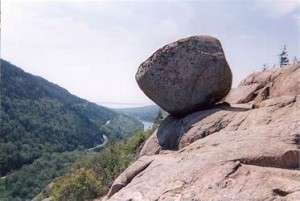
Philosophers 'Stone'? Or 'Pearl' of great price? Or just artsy farsty stuff?
''On the shoulders of Giants''? Question. Cave/mountain as a means...?
"Laurens van der Post reported that shortly before his death, Jung had a dream. In his dream he saw ''high upon a high place'' a boulder in the full sun {zenith?}. Carved into it were the words: 'Take this as a sign of the wholeness you have achieved and the singleness you have become." Enlarged elsewhere.
REFRESHER: "The light of the body is the eye: if therefore thine eye be 'single', thy whole body shall be filled with light", [Matthew 6:22]. Explained within. Try the 'Help'' section.
Side note: ''Albert Einstein's surname when translated into English is - One Stone...'' ['The Chase' / 2018].
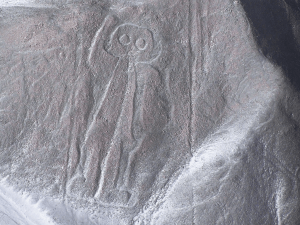 Side note: {i.e., landscape equivalent, i.e., something hinted at}: "Among the mystery schools it is often said: 'when the student is ready, the 'teacher' will appear'. And you my boy are ready - as a boulder poised at the top of a hill - and I am your 'trigger', who will raise his hand to set the boulder in motion down the slope." [Page 219. Douglas Monroe book].
Side note: {i.e., landscape equivalent, i.e., something hinted at}: "Among the mystery schools it is often said: 'when the student is ready, the 'teacher' will appear'. And you my boy are ready - as a boulder poised at the top of a hill - and I am your 'trigger', who will raise his hand to set the boulder in motion down the slope." [Page 219. Douglas Monroe book].
Top/down {'giant'?} in relation to Bottom up {'cave' / 'dwarf'?}
Francis of Assisi used it constantly. The patron saint of 'animals'. Spiritual equivalent of higher over lower. Hence the link to his quote, "as he was dying, he pointed to a crucifix saying, 'This is the 'source' of all my knowledge". [Page 441, 'The Sacred History' / J. Black. Emphasis, this readers, i.e.,think about it, relative to 'horizontal / vertical' symbolism]. Or "Then I Daniel looked, and behold there were two others. One on this side of the bank of the river, the other on the other side. And one said to the one clothed in Linen, who was upon the waters of the river, how long will it be to the end of these wonders? And i heard the man clothed in linen which was upon the waters of the river, when he held up his right and left hand unto 'heaven', and sware by him that liveth forever, that it shall be for a time, times and a half....." [Daniel12:5-6-7].
"A river of thoughts''.
 Understanding this subjects symbolism in relation to 'river' instead of sea... 'above' the water, not within or along side it, [i.e.,higher over lower]...'banks' of the river relative to 'pillars' [symbolism of], gives meaning to all that symbolism. [explained within]. Clues. 'Linen' was the Hebrew equivalent of a representation of someone beginning, 'a journey', i.e.,beginners/student 'gear'....a work still in progress.... as indicated by that first 'physical' [incarnate] example/representation of same, "who laid down with a 'young' chap in a linen cloth". Or even the thirteen layers of linen used for the mummification of Tutankhamun. Think about it, relative to a 'positive potential' within a further 'development'. All indicative of something outside of the obvious.
Understanding this subjects symbolism in relation to 'river' instead of sea... 'above' the water, not within or along side it, [i.e.,higher over lower]...'banks' of the river relative to 'pillars' [symbolism of], gives meaning to all that symbolism. [explained within]. Clues. 'Linen' was the Hebrew equivalent of a representation of someone beginning, 'a journey', i.e.,beginners/student 'gear'....a work still in progress.... as indicated by that first 'physical' [incarnate] example/representation of same, "who laid down with a 'young' chap in a linen cloth". Or even the thirteen layers of linen used for the mummification of Tutankhamun. Think about it, relative to a 'positive potential' within a further 'development'. All indicative of something outside of the obvious.
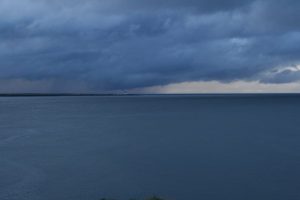 Side note: Waterford. A natural harbour at the mouth of the 'Three Sisters'. S/E Ireland {Munster}. Oldest city in Ireland. Creators of crystal glass.
Side note: Waterford. A natural harbour at the mouth of the 'Three Sisters'. S/E Ireland {Munster}. Oldest city in Ireland. Creators of crystal glass.
"Glass can form naturally from volcanic magma. Obsidian is a common volcanic glass with high silica (SiO2) content formed when felsic lava extruded from a volcano cools rapidly.[16] Impactite is a form of glass formed by the impact of a meteorite, where Moldavite (found in central and eastern Europe), and Libyan desert glass (found in areas in the eastern Sahara, the deserts of eastern Libya and western Egypt) are notable examples.[17] Vitrification of quartz can also occur when lightning strikes sand, forming hollow, branching rootlike structures called fulgurites.[18] Trinitite is a glassy residue formed from the desert floor sand at the Trinity nuclear bomb test site.[19] Edeowie glass, found in South Australia, is proposed to originate from Pleistocene grassland fires, lightning strikes, or hypervelocity impact by one or several asteroids or comets."
''Dunmore East is a fishing village and popular holiday resort situated on the west side of the harbour and is generally considered to be the western limit. On the west side, there is also a headland called Creaden Head The eastern limit is Hook Head, marked by the Hook Lighthouse, on the Hook peninsula.''[Wiki].
''Dunmore East (Irish: Dún Mór, meaning 'big fort')[2] is a popular tourist and fishing village in County Waterford, Ireland. Situated on the west side of Waterford Harbour on Ireland's southeastern coast, it lies within the barony of Gaultier (Gáll Tír – "foreigners' land" in Irish);[3] a reference to the influx of Viking and Norman settlers in the area.''
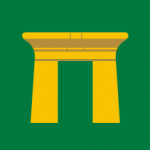 Side note: ''A late medieval text in Middle Irish named Cóir Anmann (known in English as the "Fitness of Names" or the "Elucidation of Names") gives an etymology for the term Munster {'New Name/City'?}. It claims that the name partly derives from Eochaidh Mumu, one of the early Heberian High Kings of Ireland who ruled the area.[3] This High King held the royal nickname mó-mó meaning "greater-greater" {'Duality'?}, because he was supposed to be more powerful and greater in stature than any other Irishman of his time (the Annals of the Four Masters claims he reigned from 1449–1428 BC).[3] The Cóir Anmann claims that the word mó (greater) with ána (prosperity) combined to form Mumu, because the kingdom was more prosperous than any other in Ireland.[3] The second word ána is also associated with the goddess Anu (potentially the same as mother goddess Danu). Indeed, Munster includes within it a pair of breast shaped mountains near Killarney named the Two Paps of Ána.
Side note: ''A late medieval text in Middle Irish named Cóir Anmann (known in English as the "Fitness of Names" or the "Elucidation of Names") gives an etymology for the term Munster {'New Name/City'?}. It claims that the name partly derives from Eochaidh Mumu, one of the early Heberian High Kings of Ireland who ruled the area.[3] This High King held the royal nickname mó-mó meaning "greater-greater" {'Duality'?}, because he was supposed to be more powerful and greater in stature than any other Irishman of his time (the Annals of the Four Masters claims he reigned from 1449–1428 BC).[3] The Cóir Anmann claims that the word mó (greater) with ána (prosperity) combined to form Mumu, because the kingdom was more prosperous than any other in Ireland.[3] The second word ána is also associated with the goddess Anu (potentially the same as mother goddess Danu). Indeed, Munster includes within it a pair of breast shaped mountains near Killarney named the Two Paps of Ána.
'Horizon' / ''M'' link?
Continued: ''Linen made from flax {i.e., a ''flowering plant''} - used in 'spinning and weaving' - linseed oil made from it. Belfast became its main 'harbour' in the UK.'' ['Britains Most Historic Towns: Belfast' / Alice Roberts].
Tutankhamun's linen bandages soaked in same. Set alight during his stay in the underworld. As a means...?
Death/rebirth?
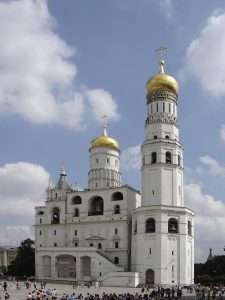
Onions.
As is the 'nine layers of coffin'. Or the ten figures with raised arms together with the 'divine couple'[explained elsewhere, together with page 64-66, 'The 12th Planet']. That link to 'twelve'[10+2] and therefore a further possible potential, represented by 'thirteen'. All indicative of a 'further' understanding. 'Above the waters'.,..a link to wet/dry symbolism, as is the symbol of the 'thirteen' scaled 'fish'. Shown purposely to be 'breathing', [Coptic equivalent]. Page 39, of the book 'The Ancient Secret of the Flower of Life'. Plus mentioned elsewhere, in picture 'form'. Find it, to understand it. Rather than 'leave to later'.
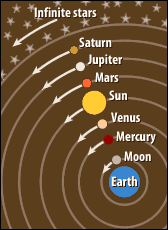
''Ptolemy, too, identified stars with parts of the 'body' of a constellation, and his model of the earth at the center of the universe was similar to that of Homer, though greater enhanced by the application of mathematics and geometry." ['Homer's Secret Iliad'].
A working example: ''I shall have to tell u something about the six centers. The mind of the yogi passes through these, and he realizes god through his Grace. Have you heard of the six centers? ...These are the SEVEN planes of the Vedas. They are the lotuses in the subtle body. The yogis see them. They are like the fruits and leaves of a wax tree {bees wax?}....I have heard there is a kind of 'glass' through which a tiny object looks very big. Likewise, through yoga one can see these subtle lotuses....How does one obtain love for god? Go forward. The king dwells beyond the seven gates. You can see him only after you have passed through all gates.....God sports in the world as man. ..The Divine Mother of the universe manifests Herself through this 'three and a half' cubit man {ishon?}.'' [Pages 352/3 'The Gospel of Ramakrishna' ].
Anima / animus or both?
Something hinted at: ''In the secret history this 'sacrifice' of the brow chakra takes place on the altar of Melchizedek, the great high priest of the Sun Mysteries....Isaac stayed at the Mystery school of Melchizedek for three and a half years....'' [Page 220 'The Secret History ofthe World' / J. Black].
Jehovah/Elohim to enlarge.
Side note: "Similarly, by its markings of the position of the equinox, the Denderah zodiac points to some epoch of antiquity which stretches back, not by centuries, but by hundreds of centuries! It thus dates early Egypt's civilization. For the position indicates that more than three and a half ''Great Years'' have been passed on the cosmic dial; that the sun has revolved around its parent sun no less than three and a half times...The Egyptian priest astronomers considered their race to be the most ancient of mankind....Herodotus was careful of his facts...known as the ''Father of History''. They had told him that ''the sun had twice risen where he now sets and twice set where he now rises..." [Page 233 'In Search of Secret Egypt' / P. Brunton].
Question. Something to be worked out beyond those ''Great Years''?
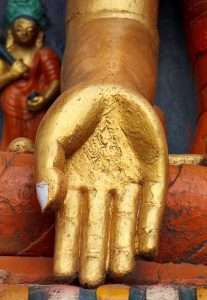
REFRESHER: ''Dragon Lord!'' he said, ''The Sun has risen in the West...and I am here...''
'Orange'?
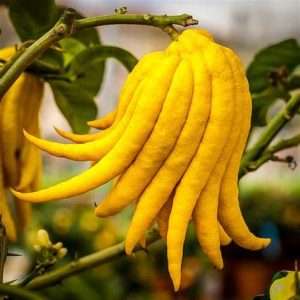
Citrus medica var. sarcodactylis, or the fingered citron, is an unusually-shaped citron variety whose fruit is segmented into finger-like sections, resembling those seen on representations of the Buddha. It is called Buddha's hand in many languages including English, Chinese, Japanese, Korean, Vietnamese, and French.
Side note: ‘Sherbet lemon’ and ‘Acid Pops’ are used as passwords to Dumbledore’s office, and his preferred jam flavour could be used as a question to check his identity – it’s raspberry, just in case you want to know...Professor Albus Dumbledore was particularly fond of Sherbet Lemon sweets 1. In fact, he brought some along with him on the night he and Professor McGonagall went to leave infant Harry Potter with the Dursleys in 1981."
'Golden child'?
Continued: Other books mentioned of the same ilk, but from different 'perspectives'...compare, to 'obtain' those common links [keys]. All enclosed within. That same representation within those 'T' shaped pillars at Gobekli-tepe. In the main, will be seen with no four legged 'animals' on those horizontal pillars, {i.e.,mainly 'birds'} - only on those 'below'. Think about it in relation to the meaning of 'Israel', relative to the 'Tau', and that 'relationship' to the meaning of 'Moses'. All with the reader / observer in mind..."and his days shall be 120 years [Beresheet 6:3] alludes to Moses. Through him the Torah was given."[Section 478,vol one ,The Zohar by Rev Berg]. Relates to number symbolism, by way of '12'. Recall, Moses who never crossed over to the other side of that 'river'.[Higher of the lower?]. Or something else.
Rostau?
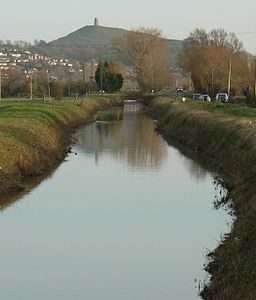
Isle of 'glass'.

In the form of 'two triangles'. Above/below. Fire/water. That same shape that can be seen on the 'hind quarters' {left} of the 'headless' Sphinx on the east side at Gebel el Silsila. Question. What god/goddess represents ''an hour''?
Side note: ''Twentyfour is the number of totality, since it is connected to the 24 hours of the day and night - although in antiquity the day was counted in 12 double hours of 120 minutes each - and in nautical reckoning, the glass, equalling 30 minutes measured by the hour glass, was maintained till recently. Twentyfour also appears as a measurement: the ancient German Elle, or yard, consisted of 24 finger's' breadth.'' [Page 235 'Mystery of Numbers' / A. Schimmel].
Anglo Saxons?
"Glass can form naturally from volcanic magma. Obsidian is a common volcanic glass with high silica (SiO2) content formed when felsic lava extruded from a volcano cools rapidly.[16] Impactite is a form of glass formed by the impact of a meteorite, where Moldavite (found in central and eastern Europe), and Libyan desert glass (found in areas in the eastern Sahara, the deserts of eastern Libya and western Egypt) are notable examples.[17] Vitrification of quartz can also occur when lightning strikes sand, forming hollow, branching rootlike structures called fulgurites.[18] Trinitite is a glassy residue formed from the desert floor sand at the Trinity nuclear bomb test site.[19] Edeowie glass, found in South Australia, is proposed to originate from Pleistocene grassland fires, lightning strikes, or hypervelocity impact by one or several asteroids or comets."
Side note: "Runnymede is a water-meadow alongside the River Thames in the English county of Surrey, and just over 20 miles (32 km) west of central London. It is notable for its association with the sealing of Magna Carta, and as a consequence is, with its adjoining hillside, the site of memorials. Runnymede Borough is named after the area, Runnymede being at its northernmost point. The name Runnymede refers to land in public and National Trust ownership in the Thames flood plain south-west of the river between Old Windsor and Egham. The area includes (to the west of A308 road) the Long Mede and Runnymede, which together with Coopers Hill Slopes is managed by the National Trust. There is also a narrower strip of land, east of the road and west of the river, known as the Yard Mede. On the west bank of the river, at the southern end of the area shown on the above map, are (inter alia): a recreational area with a large car park; a number of private homes; a large distribution centre; and a hotel. The landscape of Runnymede is characterised as "Thames Basin Lowland", an urban fringe. It is a gently undulating vale of small fields interspersed by woods, shaws, ponds, meadows, and heath.[1] The National Trust area is a Site of Nature Conservation Interest (SNCI) which contains a Site of Special Scientific Interest. Both sites are overseen by Runnymede Borough Council.[1]
The sealing of Magna Carta is also popularly associated with Magna Carta Island, on the opposite (east) bank of the Thames.[3] It has also sometimes been associated with the nearby Ankerwycke Yew. These and their surrounding landscape of floodplain and parkland may once have formed an integral part of Runnymede, as the river has occasionally changed its course here. Ankerwycke and the ruins of the 12th-century Priory of St Mary's were both acquired by the National Trust in 1998. As the Thames forms the county boundary at this point, these areas now lie in Berkshire...."
Stirling Castle.
''The human body typically, has twentyfour RIBS.'' ['The Chase'].
Adam/Eve?
And/or: ''Sing a song of sixpence, pocket full of rye. Four and twenty blackbirds baked in a pie.''
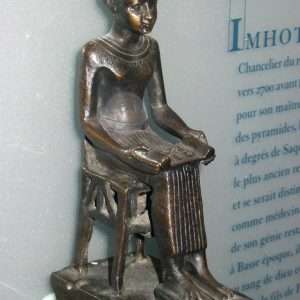
Imhotep: "To be sure, twenty is not exactly interesting for mystical and magic pursuits, but on the other hand, it is extremely important in the formation of number systems. For the simple reason that the toes and fingers add up to 20. Among the Celts, for example, 40 is called two times 20. The Ainu of Northern Japan express, for instance, 80 as 4 times 20, which corresponds exactly to the French quatre-vingts....In Germany one still finds remnants of an earlier use of 20, as a comprehensive number. 1 Ries of paper, 20 sheets, forms a "book" ; 1 Stiege consists of 20 eggs or sheep. The term Stiege can also be used for 20 yards of linen....In English the old "score" of 20 is still in use, as is three score and 1 = 61." ['Mystery of Numbers' / A. Schimmel].
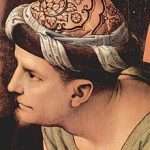
Linen headcloth? Old or New Testament BOOK?
"The Ankerwycke Yew is an ancient yew tree close to the ruins of St Mary's Priory, the site of a Benedictine nunnery built in the 12th century, near Wraysbury in Berkshire, England. It is a male tree with a girth of 8 metres (26 ft) at 0.3 metres.[1] The tree is at least 1,400 years old,[2] and could be as old as 2,500 years.[3]
On the opposite bank of the River Thames are the meadows of Runnymede and this tree is said to have been witness to the sealing of Magna Carta. The tree is also said to be the location where Henry VIII courted Anne Boleyn in the 1530s.
Here the confederate Barons met King John, and having forced him to yield to the demands of his subjects they, under the pretext of securing the person of the King from the fury of the multitude, conveyed him to a small island belonging to the nuns of Ankerwyke [the island], where he signed the Magna Carta. { J. J. Sheahen, 1822}.[4]
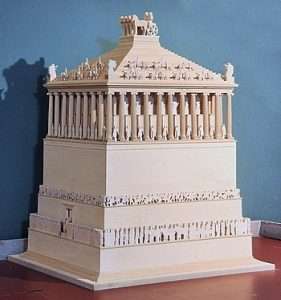
Mycenaean's used a beehive shape. Odysseus to enlarge.
There is some justification for the hypothesis that the Ankerwycke Yew could be "the last surviving witness to the sealing of Magna Carta 800 years ago".[5] "In the 13th century, the landscape would have been different as the area was probably rather marshy as it was within the flood plain of the Thames. The Ankerwycke Yew is on a slightly raised area of land (therefore dry) and with the proximity of the Priory perhaps both lend some credibility to this claim."[6]
The Ankerwycke Yew is situated on lands managed by the National Trust. In 2002 it was designated one of fifty Great British Trees[7] by The Tree Council."
A work in progress: ''In Greek mythology, Cetus was the sea monster that was sent by Poseidon to devour Andromeda, daughter of King Cepheus of Ethiopia. In some accounts, the Greek hero Perseus used the Medusa's head to turn Cetus to stone; in others, Perseus killed Cetus with his sword....Perseus is the constellation with twentyfour stars.''
Eridanus / Melusine{a} / Jonah to enlarge.
''The stars that correspond to Eridanus are also depicted as a river in Indian astronomy starting close to the head of Orion just below Auriga. Eridanus is called Srotaswini in Sanskrit, srótas meaning the course of a river or stream. Specifically, it is depicted as the Ganges on the head of Dakshinamoorthy or Nataraja, a Hindu incarnation of Shiva. Dakshinamoorthy himself is represented by the constellation Orion.
The stars that correspond to Eridanus cannot be fully seen from China. In Chinese astronomy, the northern part is located within the White Tiger of the West (西方白虎, Xī Fāng Bái Hǔ). The unseen southern part was classified among the Southern Asterisms (近南極星區, Jìnnánjíxīngōu) by Xu Guangqi, based on knowledge of western star charts.''
N.B. In the WEST it begins at the left foot of Orion.
Refresher: East is a beginning. West its ending.
Aries/Pisces?
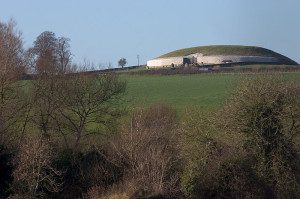
Revolving castle? 23 layers? Question. Any 'bend' in a river?
Continued: "A different 'take' on the same {theme?}: "Gwenddoleu's wonderful 'orchard' was guarded by two 'dusky birds', and each one wore a 'yoke of gold'...The two dusky birds are similar to the ravens of Odin {mentioned elsewhere} - they represent the divinity powers, the 'organ' of {clairvoyant?} sight, a universal faculty in ancient times, which depended upon a peculiar vibratory relationship between two parts of the brain whose function, today, have become more or less atrophied as far as clairvoyance is concerned. The effect, when this peculiar relation was established, was, to the clairvoyant observer of the process {objective clause?} - like a revolving form of light {seen?} above the forehead, resembling wings or 'petals' {chakra link?}. In representations, for example, of the Egyptian god Amun , they were shown as a knotted or twisted structure ending in two horns. For this reason Moses was also depicted with horns {as was other individuals such as Alexander}." ['The Flaming Door: The Mission of the Celtic Folk Soul' / E. C. Merry. Emphasis, this readers - with the exception of the words 'organ' and observer].
''Observer'' in relation to :"The children of Seth first possessed that peculiar sort of wisdom, which is concerned with the heavenly bodies." Enlarged throughout.

A-swan? 'White without spot'?
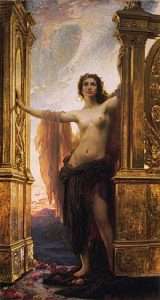
Goddess of Dawn. "Often in dreams there is an image of a new landscape, sometimes seen through a doorway, archway, or window. For as we work upon the contents of the unconscious so there is an expansion of consciousness..." [Page 48 Llewellyn Vaughan-Lee]. 'Garment to enlarge.
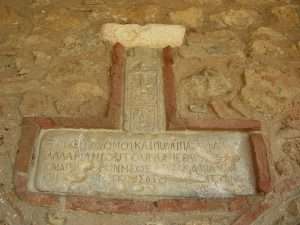
Expansion: Birket Habu to enlarge. And/or: "It is here i must leave you'. {Galdalf}. 'Thats a shame, i quite liked having a wizard around. Seems they bring good luck' {Bilbo Baggins}. 'You dont really suppose do you, that all your adventures and escapes were managed by mere luck? Magic rings should not be used lightly Bilbo. I know you found one in the Goblin tunnels. Dont take me for a fool - i have kept an eye on you ever since.'.... 'You needn't worry about that ring, it fell out of my pocket, during that battle.'......'Your a very fine person Mr Baggins and i'm very fond of you. But your only a quite little fellow in a WIDE WORLD after all.'' ['The Hobbit: The Battle of the 'FIVE' Armies']. 'Ishon' to enlarge.
Elephant Island. Aswan.
Sheep decans to enlarge.
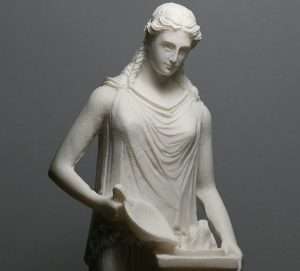
Hestia. Kitchen maid?
And/or: "Whenever one finds oneself reacting with more feeling or emotion than is justified by the objective situation {'clause'}, then something has 'come up' from the unconscious, AND there is an oportunity to get hold of the 'prima materia'. It is, therefore, important to try to differentiate between what belongs to the external situation , and is an appropriate responce, and what is primarily a reaction, something belonging to ones own unconscious patterns which have been 'triggered' off by the external situation. And because such unconscious material is not valued by the conscious mind, and is often considered humilating, it is left lying around in the dusty corners of our lives - where it can be found by the simple act of 'sweeping'. The opus begins by looking into these dusty corners and valuing what is found there, however disagreeable. The very act of taking notice of ones moods or reactions, and trying to understand their source, allows consciousness to begin to grasp and thus work with the unconscious. For most people today, the alchemical workshop is in the field of personal relationships. While the alchemists projected their unconscious into the mysterious process of chemistry, we project our psychic contents most easily on to our relationships. Personal relsationships form the groundwork for most analytic work, for it is here that we appear to have the least 'conscious control' of ourselves, and where the unconscious finds greatest room for expression." [Pages 41-2 'The Lover and the Serpent'].
Side note: The 'first undertaker' of Egypt goes looking for the tomb of Nefertiti in the Valley of the Kings. Among other ''riches'' is found a silver ring - with symmetrical spiral forms - either side of which are six and seven 'loops' respectively i.e., 'thirteen' in total. At the west end of the valley a semi-circular form can be seen - in other words a 180 degree about turn. ['Valley of the Kings: The Lost Tombs' / Discovery Channel / 8/8/21].
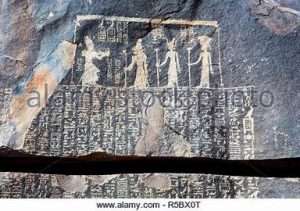
Whats the crack? {pun}. Question. Whats the remedy or what would the offering be to placate the 'gods'?
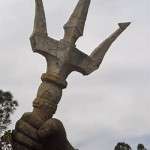
Metal of the mind.
''And when she comes, we see the anima with all its attributes: 'With a robe of flame-red silk about her {'worm' link?}, and around the maidens neck a torc of red gold {Boudica?}, and precious pearls and rubies. Yellower was her head than the flower of the bloom, whiter was her flesh than the foam of the wave; whiter were her palms and her fingers {twenty-four'?} than the shoots of the marsh trefoil from amidst the fine gravel {therefore wet/dry} of a welling spring {swallow spring?}.....Whiter were her breasts than the breast of the white swan, redder were her cheeks than the reddest foxgloves.....Four WHITE trefoils sprang up behind her wherever she went; and for that reason was she called Olwen.....Trefoil, was celebrated by the Welsh Bards....Homer called it 'the Lotus' and mentioned it as a rich fodder for horses.'' [Page 50 'A Celtic Quest' AND P. 204 'The White Goddess'}.
'Birds Foot Trefoil' = triple aspect?
Refresher: "The 'flower' {Lotus?} which is the key to modern Spiritual development is the ajna, the chakra located between the eyes. This flower is dual lobed, which is why in some literature, it is described as having two petals. It is said to be presided over by the hakini."[Bibliographic notes to chapter 5, 'The Zelator'. Mentioned elsewhere]. Breathing easier?
''The two headed briar''? {i.e., same page 'A Celtic Quest'].
In other words an aspect of the minds eye? That ''organ'' that we all use without being {in the main} aware of it? And which we use in multiple circumstances for anything and everything including learning subject material. The only difference is - this subject has a different 'dimension' to it. Yes or No?
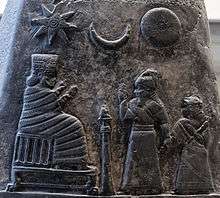
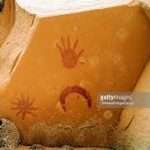 "The discovery of the tomb [Christian Rosencreutz] appears to be by accident. In fact it had been pre-destined. This is revealed by certain singular events and apparent coincidences. This , as anyone with a modicum of first hand esoteric experience will aver, is a hallmark of inner / outer plane mediation. The circumstances of the discovery are that, after 'death' of Christian Rosencreutz, the succession of his office was handed on first to Fr. D. and then to Fr. A. who, on his death bed, announced to his successor Fr. N. N. that a great discovery was shortly to be made. Fr. N. N. happened to be an architect [an interesting hint of the links to freemasonry] and decided to make some alterations to 'his building' before going on 'a journey.' Accordingly he moved a memorial tablet of brass that recorded 'all the names of the brethren with some few other things.' This necessitated removing a great nail, which in turn revealed a hidden door, upon which was written the year, and the statement in great letters ''after 120 years i will be revealed.'' It is worth noting that this is an interior discovery." [Extract taken from part 3, 'The Rose Cross and the Goddess.' Mentioned elsewhere].
"The discovery of the tomb [Christian Rosencreutz] appears to be by accident. In fact it had been pre-destined. This is revealed by certain singular events and apparent coincidences. This , as anyone with a modicum of first hand esoteric experience will aver, is a hallmark of inner / outer plane mediation. The circumstances of the discovery are that, after 'death' of Christian Rosencreutz, the succession of his office was handed on first to Fr. D. and then to Fr. A. who, on his death bed, announced to his successor Fr. N. N. that a great discovery was shortly to be made. Fr. N. N. happened to be an architect [an interesting hint of the links to freemasonry] and decided to make some alterations to 'his building' before going on 'a journey.' Accordingly he moved a memorial tablet of brass that recorded 'all the names of the brethren with some few other things.' This necessitated removing a great nail, which in turn revealed a hidden door, upon which was written the year, and the statement in great letters ''after 120 years i will be revealed.'' It is worth noting that this is an interior discovery." [Extract taken from part 3, 'The Rose Cross and the Goddess.' Mentioned elsewhere].
Side note: ''Its like a nail from outside nailing my will.'' {prior to the five wounds}. [Page 110 'Meditations on the Tarot'].
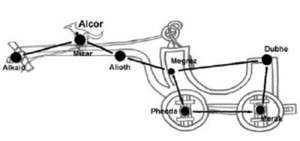
"In North Germany Alkor, as there written, has been der Hinde, the Hind, or Farm Hand; in Lower Germany, Dumke; and in Holstein, Hans Bumken, Hans the Thumbkin, — the legend being that Hans, a wagoner, having given the Saviour a lift when weary {'153'?}, was offered the kingdom of heaven for a reward ; but as he said that he would rather drive from east to west through all eternity, his wish was granted, and here he sits on the highest of the horses of his heavenly team. A variant version placed Hans here for neglect in the service of his master Christ ; and the Hungarians call the star Oontzol, with a somewhat similar tale. Another Teutonic story was that their giant Orwandil, our Orion, having frozen one of his big toes, the god Thor broke it off and threw it at the middle horse of the Wagon. where it still remains." 'Mourners' to enlarge.
And/or: ''The Vikings saw the Pole Star as a nail, which the heavens revolved around. The only culture to describe Orion as a woman - the goddess Frigg. A Spindle weaver, weaving garments for all.'' ['Mirthy'].
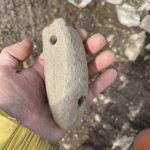
Net sinker found at the site
A work in progress: The Kame of Isbister {Shetlands}, a rock stack of mica slate with a covering of clay, attains a maximum height of 38m. and encloses an area some 95m N-S by 55m transversely which slopes steeply from E-W. It is joined to the mainland by a knife-edge ridge, half way along which a rocky boss now denies access. It is recorded that a footpath formerly traversed the ridge, but this has since been eroded by cliff falls.
When Cockburn (G Gordon 1878) visited the site in 1876, he noted 23 {'twentythree'} buildings constructed of earth and stone, set into the steep slope, and measuring from 10-24' in length and 8-10' in breadth. In a majority of cases the doors faced SE., but this was purely a matter of convenience. He dug trenches into two of the houses, but found only ashes, fire-marked stones, and the remains of a 'nail or some instrument of iron.'
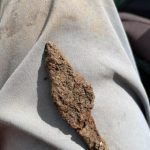
An iron angle backed knife found at the site. 'Opening of the Mouth'? 'Whale' to enlarge.
There were no bones or shells..Local volunteers have been helping too, with one finding an iron angle backed knife in the settlement, common in both Viking and Pictish settlements...The Kame of Isbister was first excavated in 1876 where approximately 23 buildings were recorded and hearths identified.
The Kame is a rocky headland 38 metres high only accessible by ropes. Professional climber Liam Malone has been on hand to assist with access along the precarious path to the site....
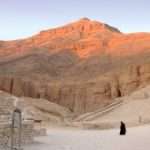
'She who loves silence'.
The Kame of Isbister, a virtually inaccessible, exposed, rock stack is a situation no sensible fishermen would choose, and there are no suitable harbours nearby. The possibility that it was a Viking settlement can be discounted for the same reasons. The site has clearly been selected for purposes of refuge and isolation - it is effectively screened from the land - and the obvious need for privacy provides a clue to its identity. There is documentary evidence that Irish missionaries reached the Northern Isles in the 7-8th centuries AD.
Continued: "...It is not enough simply to learn the 'intellectual' facts about esoteric philosophy, to have them affixed as if on a brass plate or tablet in the mind. One must go beyond them. This entails a willingness for transformation, to be a rebuilder of one's own soul, eager to break down that which is no longer of use, and to reconstruct where called to do so. This removal of the nailed metallic plate to find the 'hidden door' is likewise the finding of the center of the 'magic' circle of life experience." [Same book]. 'Lower' in relation to 'higher'?
Dawn of a new day.
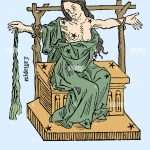

Large 'W' below. 'M' above?
A working example: ''The important thing about the practice of magic {''enchantment'' link}, is to identify the thread {therefore 'weaving'/'net' link}, which links everything and unites all creatures in a chair of cosmic union {'UNfolded'?}. And whether it be 'encircling hearts' or 'encircling the solar circuit' - as in an embrace, the Menat neck-lace {Menit} at Denderah represents such a 'movement'...'' Page 92 'Hathor's Alchemy'].
Cursus link.
Calypso to enlarge.
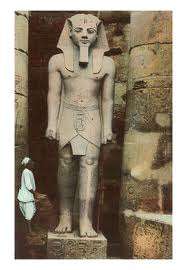
Static / Dynamic.
Exercise {Apply the above to get a 'hang' on a mind set}: ''Sometimes, a single image speaks louder than words...At Denderah on the crypts south wall {S/E corner of its lowest chamber}, is a relief evoking Harsomtus's birth {aspect of Horus}. It depicts a pair of OVAL shapes, each enclosing a snake and surging from a lotus which opens at dawn revealing same in the Day Boat....Movement means life. Plutarch explains that the sistrum indicates 'the things which exist should be shaken and should never stop moving'...'' [Page 88].
Understanding that ''universal framework'' defines the above in relation to the true meaning and distinction between incarnation and reincarnation - IN THE PRESENT MOMENT/TIME.
Smith/Jones to enlarge.
A {working?} example, i.e.,in the present moment?: "There exists a possibility of experimental verification of the relation of personality to essence. In Eastern schools ways and means are known by the help of which it is possible to separate man's personality from his essence. For this purpose they sometimes use hypnosis, sometimes special narcotics, sometimes certain kinds of exercises. If personality and essence are for a time separated in a man by one or another of these means, two beings, as it were, are formed in him, who speak in different voices, have completely different tastes, different aims and interests, and one of these two 'beings' often proves to be on the level of a small child..." ['In Search of the Miraculous'].
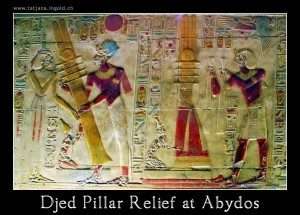
''Djed - efre has risen''? AND/OR: ''Out of Egypt, have i called my Son.'' [Matthew 2:15].
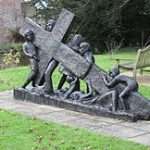 "The Kingdom of Heaven is within you. The time has come for external forms and expressions to be left behind. There is no Temple in the heavenly Jerusalem, for religion has no place in Heaven. Man is his own Temple. A mans heart is the altar of god...." [First chapter,{'The inner Quest'} from the book 'The Mind of Christ' {Meditations on Christian Themes} by Anthony Duncan].
"The Kingdom of Heaven is within you. The time has come for external forms and expressions to be left behind. There is no Temple in the heavenly Jerusalem, for religion has no place in Heaven. Man is his own Temple. A mans heart is the altar of god...." [First chapter,{'The inner Quest'} from the book 'The Mind of Christ' {Meditations on Christian Themes} by Anthony Duncan].
Analogy of same, with the same intent..."The tomb from which the saviour will arise is the heart of men and women; if the good in them awakens to self-consciousness, then will it appear to them as a sun, shedding its light upon a better and heavier generation." Quote from the book by F. Hartman.
'120' and/or ''giants''?
And/or: ''Neither the New Testament nor the Church Fathers allude to Mary Magdlene's fate after the resurrection. Likely she was among the one hundred and twenty in the Upper room, participating in the beginnins f the early Church formation {'Foundation'?}: Beyond that different traditions offer possibilities about how her life continued....'' [ Page 97 'Mary Magdalene: Insights from Ancient Magdala' / J. Ristine].
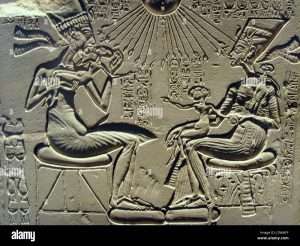
What are EACH sat on?
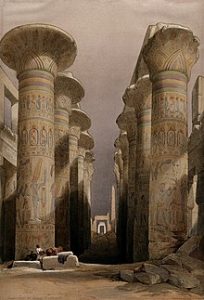
The middle ground?
Side note: If you want to understand the question more readily, said Socrates, consider it with reference not only to human beings but to all animals and plants. Let us see whether in general everything that admits of generation is generated in this way and no other—opposites from opposites, wherever there is an opposite—as for instance beauty is opposite to ugliness and right to wrong, and there are countless other examples. Let us consider whether it is a necessary law that everything which has an opposite is generated from that opposite and from no other source. For example, when a thing becomes bigger, it must, I suppose, have been smaller first before it became bigger? Here is another question. Do not these examples present another feature, that between each pair of opposites there are two processes of generation, one from the first to the second, and another from the second to the first? Between a larger and a smaller object are there not the processes of increase and decrease, and do we not describe them in this way as increasing and decreasing?
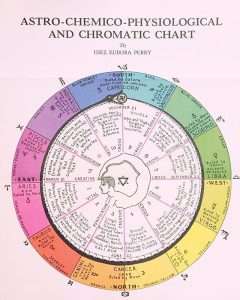
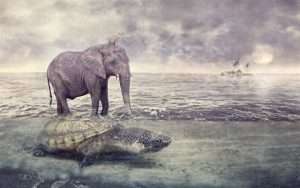
Heavy feet?
The actual terms, must it not in fact hold good universally that they come one from the other, and that there is a process of generation from each to the other? So if they are opposites, they come from one another, and have their two processes of generation between the two of them? I think there is another way too, Cebes, in which you can see that we were not wrong in our agreement. If there were not a constant correspondence in the process of generation between the two sets of opposites, going round in a sort of cycle, if generation were a straight path to the opposite extreme without any return to the starting point or any deflection, do you realize that in the end everything would have the same quality and reach the same state, and change would cease altogether? After spending some time in reflection Socrates said, What you require is no light undertaking, Cebes. It involves a full treatment of the causes of generation and destruction. If you like, I will describe my own experiences in this connection, and then, if you find anything helpful in my account, you can use it to reassure yourself about your own objections. ['Plato: Collected Dialogues'].
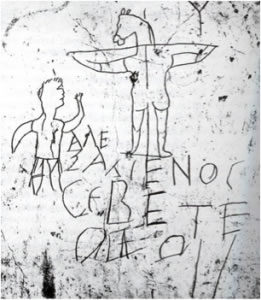
I have seen the sun at midnight. [Apuleius, The Golden Ass]. Question. Why Midnight? Clue the eve of a new day. The tail end of something and therefore the beginning of something else? Son of?

The face of Halloween or April 1st?
Q...Purpose of the ‘Feast of Fools’ and the ’Golden Ass’ story in relation to thunder / lightening keys. Link to..’Apes and ape lore in the middle ages and renaissance’. Studies of the Warburg institute. That link to C. Jungs quote in the forward to ‘The Trickster character' /P. Radin.
That link to the legend of ‘Fulcanelli’, [purpose of].
"We left shortly thereafter and i gave no further thought to the matter. I didn't stay in touch with the Paris people - wanted to get away from all that social involvement. Then in 1926 i find out about the publication of 'Le Mystere des Cathedrales!' It was entirely based on my work!''... ' I recall that this session ended abruptly about this point - and while we were to return to the subject of those mysterious manuscripts in the near future, he never again mentioned the two fold 'theft and trickery' at the heart of Fulcanelli '." [From the book 'Al-Kemi' by A. Vandenbroeck. Emphasis, this readers].
Question. Within the same book one member of the family had not to be left alone. Why?
 ".....For this reason certain calendrical days were set aside when all the norms of society were released, or even inverted. In the Roman Mysteries, the important period of such misrule had been the 'Saturnalia'. Important elements from this festival were carried over, almost intact, to the mediaeval Feast of Fools. During this feast, the priests would dress as clowns and women, and generally 'act the fool'...I too had observed that Fulcanelli did not deal with the Feast of Fools has he might have done, This puzzled me too, for the evidence of the Fool is scattered through many of the mediaeval documents with which he was familiar. Such fooling is also frozen in the very stone, on the cathedrals he discussed in such arcane detail..." [Chapter 7, 'The Zelator'].
".....For this reason certain calendrical days were set aside when all the norms of society were released, or even inverted. In the Roman Mysteries, the important period of such misrule had been the 'Saturnalia'. Important elements from this festival were carried over, almost intact, to the mediaeval Feast of Fools. During this feast, the priests would dress as clowns and women, and generally 'act the fool'...I too had observed that Fulcanelli did not deal with the Feast of Fools has he might have done, This puzzled me too, for the evidence of the Fool is scattered through many of the mediaeval documents with which he was familiar. Such fooling is also frozen in the very stone, on the cathedrals he discussed in such arcane detail..." [Chapter 7, 'The Zelator'].
The ''He'' is a She. Question. Who could that 'She' be?
''There is some indication , based on the use of the third person plural, that Fulcunelli was a community {ummah?} or sangha of alchemists. Like many of the Masonic and Rosicrucian orders of fraternity, Fulcunelli, whether individual or sangha, reached out to the world at large through their manifestos and alchemic texts. This was done in order to inspire the minds of those who are true seekers..." [Foreword to the book 'The Dwellings of the Pholosophers' / Fulcunelli].
There can only be a few possibilities, considering the generation AND/OR era that the story 'evolved' in. In other words who would know this subject [by way of the 'Alchemical' one]... well enough... to play the 'fool'.
Picture...South west in relation to North east. 'Younger' relative to 'elder'. The beginning of something. 'Death'....'rebirth'..its mid point. Hebrew equivalent Yhwh. Y = 700 [number symbolism]. 'Top right corner'. Possibilities of. See anything?
"This 'higher' intelligence, this ''sun at midnight'', which is the conjunction of the spiritual sun and the spiritual moon - or, in other words, the intimate union of intelligence and wisdom - is the 'star' of Hermeticism. It is the 'sun' of the 19th arcanum. It is the principle of intuition, or the intimate union of 'transcendental' intelligence and wisdom...It is called to effect the passage from argumentative reasoning to comprehensive intuition." [Extract from the book by Tomberg]. Remember - representational of.
Sirius?
"The word 'spiritual' should be associated with the word 'eyes'. This is a reference to the eyes of the mind or heart. To see is to understand." [From the book by T. Nottingham].
Example of: i.e.,once that ''intuition'' is applied - relative to a subject - it can be used - [amongst other things]- to decipher the following...
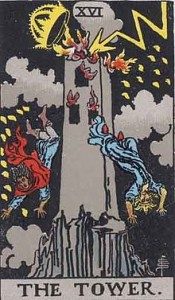
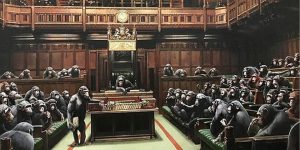
''Could someone point out the Foreign Secretary! We need to know more about his inside information on certain members of the British public - who suposedly are masquerading as bank robbers or letterboxes.....Reputations could be tarnished!''
" M. Canseliet [Eugene] was taken to his room, on the first floor, in a tower of the manor...Returning to his rooms, M. Canseliet went to his window to breath some fresh air and observed the patio below. He saw a group of children - probably children of the other guests at the manor - who were playing. But there was something strange about them. In looking more closely, he realized it was in the clothing they were wearing. They looked like they were from the 16th century. The children were playing some sort of game, and M. Canseliet thought they were dressed this way for a masquerade or costume party {Saturnalia?}. That night he went to bed without thinking more about the incident. The next day, he returned to his experiments in the laboratory he had been given. From time to time his master ['Fulcanelli'] visited him briefly to watch over his progress. One morning, M. Canseliet, descending the staircase of the tower in which he was staying, found himself under a vaulted porch, that opened on to the patio when, suddenly, he heard voices. Crossing the patio, he approached a group of three woman who were talking animatedly. M. Canseliet was surprised to see that they were wearing ample and long clothes in the style of the 16th century, just like the children he had seen two days previously. M. Canseliet was torn between surprise at what he was seeing and embarrassment at being dressed so casually. He went to turn around to his rooms when, as the women passed by, one of them turned abruptly, looked at him, and gave him a smile. All this lasted only an instant. The woman rejoined her companions...M. Canseliet remained shaken because he could have sworn that the face of the woman who had given him the smile was that of Fulcanelli..." [Taken from the book 'Fulcanelli' by P. Riviere. Also within the book 'The Fulcanelli Phenomenon' by K. R. Johnson].
Understand those keys to' see' something other than the obvious, i.e.,...
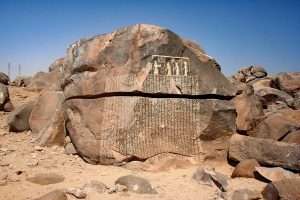
Opening?
'On Having No Head: Zen and the Rediscovery of the Obvious' / D. E. Harding.
Side note: ''Bushy Oak, leafy Oak. You TOWER above all trees....O Hazel, little branching one, a coffer 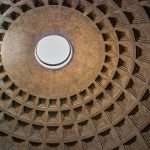 for sweet nuts...O apple tree, true to your kind. You are much SHAKEN by men...'' [Page 444 'The White Goddess' / R. Graves].
for sweet nuts...O apple tree, true to your kind. You are much SHAKEN by men...'' [Page 444 'The White Goddess' / R. Graves].
A coffer (or coffering) in architecture is a series of sunken panels in the shape of a square, rectangle, or octagon in a ceiling, soffit or vault.[1] A series of these sunken panels was often used as decoration for a ceiling or a vault, also called caissons ("boxes"), or lacunaria ("spaces, openings"),[2] so that a coffered ceiling can be called a lacunar ceiling: the strength of the structure is in the framework of the coffers....A prominent example of Roman coffering, employed to lighten the weight of the dome, can be found in the ceiling of the rotunda dome in the Pantheon, Rome.'' [Wiki].
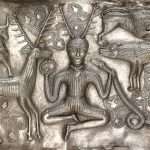
''Seated'' ='Throne'?
''The building is cylindrical with a portico of large granite Corinthian columns (eight in the first rank and two groups of four behind) under a pediment. A rectangular vestibule links the porch to the rotunda, which is under a coffered concrete dome, with a central opening (oculus) to the sky. Almost two thousand years after it was built, the Pantheon's dome is still the world's largest unreinforced concrete dome.[3] The height to the oculus and the diameter of the interior circle are the same, 43 metres (142 ft).''
It is one of the best-preserved of all Ancient Roman buildings, in large part because it has been in continuous use throughout its history and, since the 7th century, the Pantheon has been in use as a church dedicated to "St. Mary and the Martyrs" (Latin: Sancta Maria ad Martyres) but informally known as "Santa Maria Rotonda".[5] The square in front of the Pantheon is called Piazza della Rotonda.''[Wiki].
Side note: ''In 1995, Marie and Pierre Curie were reburied in the Pantheon – the Paris mausoleum reserved for France's most revered dead – on the orders of French President Mitterand. Marie Curie was the first woman to be awarded a place in the Pantheon for her own achievements....
Curium is a transuranic, radioactive chemical element with the symbol Cm and atomic number 96. This actinide element was named after eminent scientists Marie and Pierre Curie, both known for their research on radioactivity....Curium is a hard, dense, silvery metal which glows purple in the dark and is part of the actinide series of elements.''
“Radium,” she said. “Radium?” “Those were her last words— 'Was it done with radium or with mesothorium?''
'137' ?

Childs-play?

Blobby or Slobby? Anyone for cheese and crackers if only on a Friday!
Continued: "I know nothing, and all preconceived opinions have been taken from me, which is the beginning of learning, i.e.,that one must first become a child, and then be wet nursed into knowledge, as is now taking place within me." [ Quote by Emanuel Swedenborg on an ''inner'' understanding. Chapter three,'The Presence of Other Worlds'].
Refresher: Understanding the above gives clues to the 'origins' of the following: " Today's travellers passing through Winster in Derbyshire may enjoy the unexpected sight of a man dressed as a woman from a centuries old tradition. So old, in fact, that nobody knows where it came from - Morris dancing..." [Britain's Ancient Tracks'. Narrated by T. Robinson. Series 2. Episode 3]. Other clues elsewhere. Try ''Morris''.
 Side step: "They build their individual towers of Babel which fall, as a rule, according to the law of all towers of Babel, and experience, sooner or later, a salutary fall, as is the teaching of the 16th card of the Tarot. They do not fall from a real height into a real abyss; it is only from an imaginary height that they fall and they fall only to the ground, i.e., they learn the lesson that we human beings of today have all learned or have still to learn..." [Taken from the book by the author Tomberg].
Side step: "They build their individual towers of Babel which fall, as a rule, according to the law of all towers of Babel, and experience, sooner or later, a salutary fall, as is the teaching of the 16th card of the Tarot. They do not fall from a real height into a real abyss; it is only from an imaginary height that they fall and they fall only to the ground, i.e., they learn the lesson that we human beings of today have all learned or have still to learn..." [Taken from the book by the author Tomberg].
And/or..."I've had more failures than successes. Never afraid to fail." Quote by Chris Coleman - manager of Wales prior to semi-finals in Euro 2016. First time any participant from within the British Isles had reached such an event in decades.
Refresher: "Consciousness is that which one carries within oneself, which rules from within to without until it has totally enlightened us, and it never leaves us stranded, regardless of the neglect into which one might have allowed it to fall." ['Journey into the Light'].
And/or: ''Sometimes you have to fall in order to understand how to get back up.'' {Reply} ''yes, sometimes you have to fall to find out how hard the pavement is....'' [Ryan/Danny 'Counting Cars' / History Channel].

More empathy for his golf clubs? Why did he not make that phone call to his friend in Israel asking him NOT to? Wanting to change ancestral lands into a fair ground? Presidential or glorified estate agent?

Ethnic cleansing? Were they all Hamas supporters? History repeating itself? What would Yahweh say?
Analogy : ''If the ''opening of the heart'' bestowed by this new mentality is not understood, the effect involved will be questioned: 'Why take such pains to decipher a teaching so far removed from us?' We would reply: 'It helps arrest our dangerous fall, and to give us a means to ascend towards our superhuman aim.' We must understand that everything said in this way goes well beyond our usual understanding and concerns hidden vital laws." [Page 59 'The Egyptian Miracle' / R. A. Schwaller de Lubicz].
In the modern sense of the word}: "I've done a lot of work in the community at home.

"Fake news." A political animal or a spiritual one? What will history say. TRUE history - in the material AND spiritual SENSE of the word?
I wanted them to know that mistakes happen but you can come back, if you work hard..." [Quote by Justin Gatlin after beating Bolt in the 100 meter final. 06/08/17].
And/or: "I screwed up in a big way. Then I doubled down and made more mistakes. But over the last 5 years through therapy, and coaching and surrounding myself with better people, I've cleaned things up and even though its still a work in progress I can impart that knowledge to youngsters - how you can learn from your own mistakes....Its the ones who get up time after time who acquire a masters in life." [Alex Rodriguez talking on Radio 4 {21/11/18} about his life as a baseball player over 25 years and his addiction {and recovery} to drugs].
'A-Rod: The Many Lives of Alex Rodriguez'.
Question. 'higher/lower'?

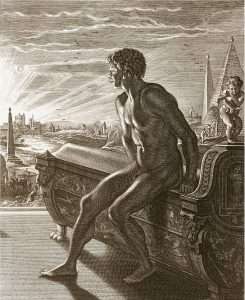
As seen from a different 'angle': "The Tower is a symbol of a state of consciousness {in this example - that of Vortigern}. It is a structure of himself {his negative self} - a retreat from fear and cowardice, a false fortress built upon inadequate foundations...It is in effect an outer expression of an inner state....This modern interpretation is built upon certain ancient key images, the best known being the biblical Tower of Babel and the Tarot Trump 'The Blasted Tower'. The Blasted Tower is not only a key that represents human frailty or imbalance typical to us all, but operates on other levels that express the catalytic energies or break-down of any state or being or structure; even the universe itself. When a construct has remained intact or has been assembled through retentive fear and force, an external agency of catalysis will eventually destroy it. This destruction, however, is the vital preliminary to fresh construction, on physical, psychic, or spiritual levels." [Page 55-56 'The Prophetic Vision of Merlin'. Emphasis/parenthesis, this readers].
Tower in relation to 'Temple'? Temple in relation to ''gnosis''? Therefore: Exo/Esoteric?
Try ''sand''.
Side note: A legend about a tower of bricks that was used to support the construction {'creation'} of the dome at the pinnacle of the Taj Mahal in India. A building about ''lost love''. Understand subject material to gain an insight into a mind set. Straight lines in relation to curves. Brick in relation to 'white' marble. South in relation to North. Built very close to a river. 'Twentyfour' pillars of brick used as foundation supports. That which was once 'lost' is now found. ['Blowing up History: Taj Mahal' / 1:4:18].
Hypnerotomachia Poliphili: The Strife of Love in a Dream.
'On Having No Head: Zen and the Rediscovery of the Obvious' / D. E. Harding.
''The sandstone gateway of the Taj Mahal features the Daybreak inscription.'' ['The Chase'].
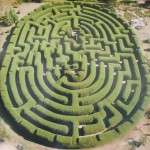
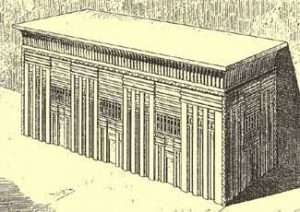
Unconscious = 'shadow' = ''recesses''?
REFRESHER: "There is a mosque whose foundation was laid from the first day on piety; it is more worthy of thy standing forth therein." [i.e., in relation to ''The original mosque of piety built by the Muhammad himself]..."Which then is best? - he that layeth his foundation on piety to God and his good pleasure? - or he that layeth his foundation on an undermined sand cliff ready to crumble to pieces?" [Quran 9:108/109].
Two tombs found within the Taj Mahal. Central one = female aspect. OFFSET one = male. Anything?
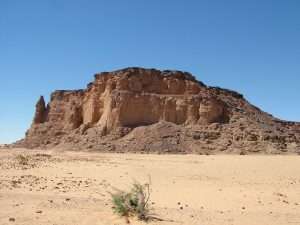
Gebel {Jebel} Barkal.
''The Taj Mahal always welcomes each of its visitors with an inscription, written in beautiful handwriting, on the great gate that reads "O Soul, thou art at rest. Return to the Lord at peace with Him, and He at peace with you." It was Abdul Haq, who created this in 1609, and was bestowed with the title of 'Amanat Khan' by none other than Emperor Shah Jahan himself. Along with spellbinding architecture and a picturesque background, the calligraphy done is one of the fantabulous ornamental decorations done on the surface of Taj Mahal. The calligraphy of the Taj Mahal mainly consists of the verses and passages from the holy book of Quran. It was done by inlaying jasper in the white marble panels. These passages were inscribed by Amanat Khan in an illegible Thuluth script. A number of the panels also bear his signatures.''
Lord Poseidon?
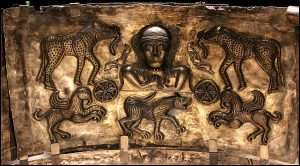
Spots and Stripes to enlarge.
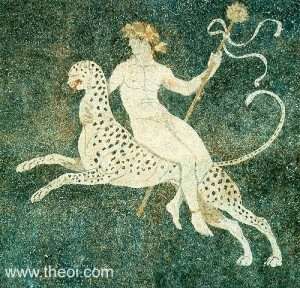 JASPER: The name means "spotted or speckled stone," and is derived via Old French jaspre (variant of Anglo-Norman jaspe) and Latin iaspidem (nom. iaspis) from Greek ἴασπις iaspis (feminine noun),[6] from an Afroasiatic language (cf. Hebrew ישפה yashpeh, Akkadian yashupu).[7] This Semitic etymology is believed to be unrelated to that of the English given name Jasper, which is of Persian origin,[8][a] though the Persian word for the mineral jasper is also yashp (یَشم).
JASPER: The name means "spotted or speckled stone," and is derived via Old French jaspre (variant of Anglo-Norman jaspe) and Latin iaspidem (nom. iaspis) from Greek ἴασπις iaspis (feminine noun),[6] from an Afroasiatic language (cf. Hebrew ישפה yashpeh, Akkadian yashupu).[7] This Semitic etymology is believed to be unrelated to that of the English given name Jasper, which is of Persian origin,[8][a] though the Persian word for the mineral jasper is also yashp (یَشم).
Green jasper was used to make bow drills in Mehrgarh between 4th and 5th millennium BC.[9] Jasper is known to have been a favorite gem in the ancient world; its name can be traced back in Arabic, Persian, Hebrew, Assyrian, Greek and Latin.[10] On Minoan Crete, jasper was carved to produce seals circa 1800 BC, as evidenced by archaeological recoveries at the palace of Knossos.[11]
Although the term jasper is now restricted to opaque quartz, the ancient iaspis was a stone of considerable translucency including nephrite.[2] The jasper of antiquity was in many cases distinctly green, for it is often compared to emerald and other green objects.
White quartz stone?

REFRESHER: ''The Swan is white without spot.''

“Most certainly, I tell you, one who doesn’t enter by the door into the sheep fold, but climbs up some other way, is a thief and a robber."
Birds of a feather flock together is an English proverb. The meaning is that beings (typically humans) of similar type, interest, personality, character, or other distinctive attribute tend to mutually associate.
The idiom is sometimes spoken or written as an anapodoton, where only the first part ("Birds of a feather") is given and the second part ("...flock together") is implied, as, for example "The whole lot of them are thick as thieves; well, birds of a feather, you know" (this requires the reader or listener to be familiar with the idiom).
And/or: If we notice ourselves when reading, three people are concerned. There is the reader, the person inside listening to him, and a judge. These three people are all present when we read. This listener cannot hear what outside people say. He listens to the reader: and notices what the judge says. In order to re-reate the world - that is, to create the world in oneself, to give it meaning, form, interpretation, order, significance - it is the listener who must learn.
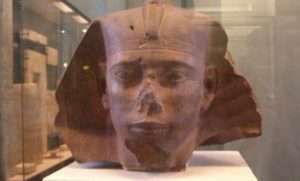
Reader, judge or listener?
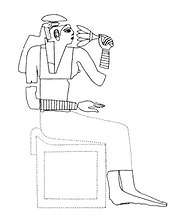
Wife / Mother / Grandmother of the Old Kingdom pharaohs.
One takes one's ideas, one's thoughts, one's feelings and one's power of imagination and works internally with them, realising that no matter what other people know or have said or have written or done, nothing has as yet happened in oneself of any value. There has been no personal assimilation of truth, no inner discovery of it, no creation in oneself. If our emotional life were more awake then the union of thought and emotion would feed this deepest and most real part of us and we would feel the happiness that comes from the mingling of meaning with life. Our behaviour would be different because everything would present itself to us with infinitely more differences than is possible as long as we receive everything in a habitual way. Life fails to nourish us because we view it habitually - through a few habits of the mind. We recognise - and do little else. We call this knowing - or even truth. {'The Mark' / M. Nichols}.
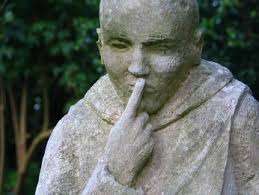
Finger width?
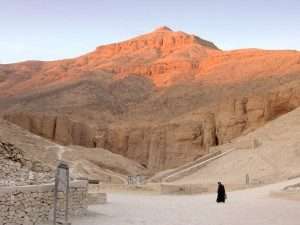
'She who loves silence'.
And/or: "Here is a method of self-creation - once we understand and apply the given ideas. At this point, it can be said, a man begins to exist - realising suddenly what it means to begin to live consciously. He is no longer a creature driven to and fro by circumstances, by fashion and by the latest craze. He is no longer so much a slave to the terrible machinery of life in which everyone is turning. He no longer thinks only in terms of a sense-engendered life. He has within him another system. By this he finds a new relation to what he experiences. Ideas different from the ideas he acquired from brute-life enter and awaken his mind.
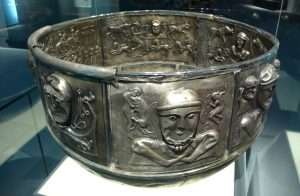
A stiring. Wooden or silver spoon?
And, listening, the meaning of these ideas gradually unfolds in his understanding. The first stage of a development of his whole being is set in motion. In his intimate conversation with himself he talks to himself in a new way, and the listener in him hears and begins to stir. The facts of life do not penetrate us deeply. The listener is continually misled by them. But some ideas can penetrate to depths that we have not previously known, and stir energies that have never been experienced." {same}.
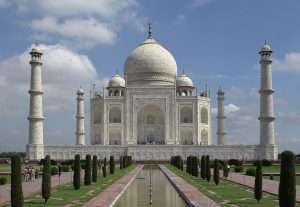
Marble {N/E} and Sandstone {S/E} as a means....
Continued: ''Black marble has been used to decorate both the south gateway and the main mausoleum with Arabic inscriptions. The texts chosen refer broadly to the themes of judgment and fruitful paradisiacal rewards for the faithful. The inscriptions over the gateway invite the reader to enter the paradise. And as one enters towards the main mausoleum, the tone of the inscriptions changes from paradisiacal to that of an impending doom that awaits the unbelievers on the Day of Judgment. However, once inside the mausoleum, the tone of the inscriptions changes yet again from judgment to paradisiacal. It is also believed that Amanat Khan even chose the passages for the calligraphy of Taj Mahal, Agra. The exterior of Taj Mahal are loaded with verses from the Quran like:

Folded or UNfolded?
Surah 91 (The Sun) Surah 112 (The Purity of Faith) Surah 89 (Daybreak) Surah 93 (Morning Light)
Surah 95 (The Fig) Surah 94 (The Solace) Surah 36 (Ya Sin) Surah 81 (The Folding Up) Surah 82 (The Cleaving Asunder) Surah 84 (The Rending Asunder) Surah 98 (The Evidence) Surah 67 (Dominion) Surah 48 (Victory) Surah 77 (Those Sent Forth) Surah 39 (The Crowds).
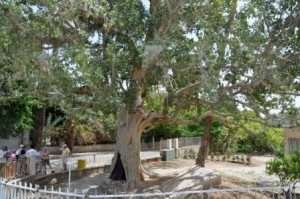
Sycamore fig tree. Mentioned 'seven' times in the Bible.
On the actual tomb of Mumtaz Mahal located in the burial chamber, the ninety names of God can be found as calligraphic inscriptions on the sides, in the crypt including "O Noble, O Magnificent, O Unique, O Eternal, O Glorious..." And the tomb of Shah Jahan bears a calligraphic inscription that reads "He travelled from this world to the banquet hall of eternity on the night of the twentysix{th} of the month of Rajab, in the year 1076 Hijri". However, the central focus is provided by passages on the upper cenotaph of Mumtaz Mahal. The words of the Quranic prayer recited by the angels, implore Allah to allow the faithful to enter paradise, a touching request for God's mercy towards His devout servant, Mumtaz Mahal.'' [Internet].
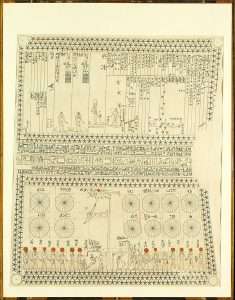
Astro ceiling in Senenmut bare tomb chamber. 'Unfolded'? No Mars - BUT Sheep Decans mentioned! Something 'NEW'?
A work in progress? "Endorsement of the view that the planets visible to the naked eye were represented by the gods came about in an unusual way. After two years cataloguing the Leigh papers, we began, warily at first, to derive astronomical images from the narrative. One of the first came from a few words in Book 1 that record the return of the gods after a few days feasting in Ethiopia: 'The immortal gods came back in a body {at dawn} to Olympus, and Zeus led the way.' An image was created of Homer describing a time when the crescent moon and the five planets visible with the naked eye could be seen close together in the sky at dawn and rising towards the zenith of the heavens, the domain of Zeus. Our inquiry into whether such a conjunction of planets is rare or common were not at first successful, but eventually the happy chance of reading an article in an astronomy magazine showed that such a conjunction on the 5th march 1953 BC had been recorded in an ancient Chinese text and had so impressed Chinese astronomers that it was used as a new starting point for their calendar....

Index finger and thumb? 'Gap'?
.....That conjunction would also have been visible from Greece {Egypt?}. In fact researchers Kevin D. Pang and John A. Banqert discovered that the five naked-eye planets had been in the sky for some days before that date, and on twentysix{th} February 1953 BC their alignment had been closer than at any time in the past six millennia. But extra significance was given to the conjunction when the new moon joined the planetary grouping at dawn on 5th March, thus adding the goddess Hera to the planets representing by Athene, Aphrodite, Poseidon, Ares and Apollo. Although they differ in literal expression, a number of translations of this event from the Iliad reflect similar astronomical images - That the gods returned in 'a line' or 'a cortege' or 'are forever all in one company'. A literal translation from the Greek texts says: 'From that {time} became the TWELFTH DAWN, then indeed to Olympus went all the ever-being gods, all at the same time and Zeus led. Whether the conjunction described by Homer is the same one that so influenced the Chinese may never be known, but so rare are such events that it is possible that it was, and had remained alive in popular memory in Greece {Egypt?} though being preserved in allegory." ['Homer's Secret Iliad'].
Side note: ''happy chance'' - coincidence or a meaningful one?
Refresher: "This knowledge is not set down explicitly in books, but is embodied in the building itself...The proportions of the Temple are those of Adamic Man, man before the 'fall' - and of 'perfected' man, man who has regained his cosmic consciousness through his own efforts..."
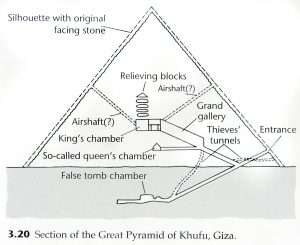
Off 'center'?
From a different perspective: ''If unconsciousness can be recognised as a co-determining factor along with consciousness, and if we can live in such a way that conscious and unconscious demands are taken into account as far as possible, then the center of gravity of the total personality shifts its position. It is then no longer in the ego, which is merely the center of consciousness, but in the hypothetical point between conscious and unconscious. This new center might be called the self....which if successful results in a personality that 'suffers' only in the lower storeys, as it were, but in its upper storeys is singularly detached from painful as well as joyful happenings....It becomes what the texts call the 'diamond body' or 'holy fruit' or any other kind of incorruptible body.''

A centering within a brain or maze?
And/or: ''If the ''opening of the heart'' bestowed by this new mentality is not understood, the effect involved will be questioned: 'Why take such pains to decipher a teaching so far removed from us?' We would reply: 'It helps arrest our dangerous fall, and to give us a means to ascend towards our superhuman aim.' We must understand that everything said in this way goes well beyond our usual understanding and concerns hidden vital laws." [Page 59 'The Egyptian Miracle' / R. A. Schwaller de Lubicz].

Narmer Palette Serekh. 'Catfish'.
Side note: "From the above inscription {i.e., in relation to the Memphite Theology, i.e.,the ''union'' of something, i.e., ''marriage'' i.e., ''lost love''?}, we can deduce that, at some point, ancient Egyptians regarded the land of Egypt as shared between Horus and Seth. Then, for reasons that are not clear, Horus was given total control of the whole of Egypt. Could it be that the Memphite Theology, reflects historical events that occurred in the late 2nd and early 3rd dynasties? Could it explain the placing of Seth on the serekh of King Peribsen, and the placing of both Seth and Horus on the serekh of King Khasekhemwy, only to revert back to just Horus on Netjerykhet's serekh? This idea has indeed occurred to some Egyptologists." ['Imhotep the African'].
Question. Literal or symbolic?
N-S / E-W...which and why?
Broad/Narrow.

Serekh of Khufu. Chick?
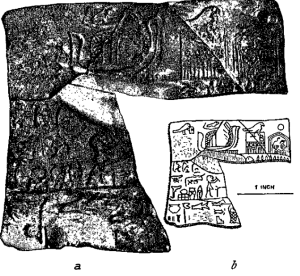
Inscription bearing Hor-Aha's serekh together with a Nebty-name expressed with the game-board hieroglyph, which could be read mn.
Serekh = ''facade'' = 'Face on' as opposed to {say} 'in profile'? Enlarged throughout.
And/or: Could the 1st {i.e.,Scorpion King?} and 4th dynasties be included. Especially the 'unfinished' or 'collapsed' pyramid of 'Djed'- efre?
Recall the significance of ''four'' - if only in the ''horizontal'' sense of the word.
Side note: The Horus name is the oldest known and used crest of ancient Egyptian rulers. It belongs to the "great five names" of an Egyptian pharaoh. However, modern Egyptologists and linguists are starting to prefer the more neutral term: the "serekh name". This is because not every pharaoh placed the falcon, which symbolizes the deity Horus, atop his (or in some cases, her) serekh.[1]
In Egyptian hieroglyphs, a serekh is a rectangular enclosure representing the niched or gated façade of a palace surmounted by (usually) the Horus falcon, indicating that the text enclosed is a royal name. The serekh was the earliest convention used to set apart the royal name in ancient Egyptian iconography, predating the later and better known cartouche by four dynasties and five to seven hundred years.
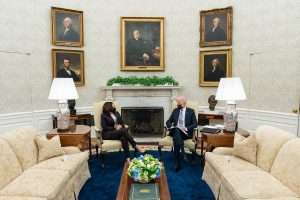
'Oval' Office.
''In hieroglyphic texts, you often see signs enclosed in oval shapes, which are called cartouches. They are quite famous because the discovery that characters thus enclosed were alphabetic letters representing the name of Egyptian kings was the crucial first step toward deciphering the ancient Egyptian writing system.
Less well-known are the square cartouches. Egyptian rulers had more than one name: a personal name and several ones taken at their installation. During the first dynasties, the ruler's most important name was written in the square{?} serekh, which means "that which makes known", i.e., the chosen identity of the ruler.
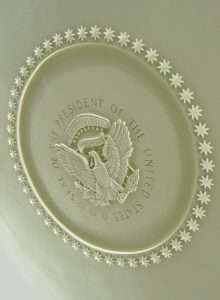
Fortynine 'stars' with 'eight' aspects each.
An example can be seen on the alabaster cup of King Djer, Narmer’s second successor. In the lower register, we can recognize a stylized representation of the façade of a palace. In the upper register, we can read the royal name, Djer. Finally, the square is surmounted by a falcon.
We do not have religious literature from this early age, but when we are able to read sacred Egyptian texts, this bird represents the god Horus, who represented cosmic order and protected the king. It is likely – although we cannot prove it – that the falcon on the serekh represented the same deity, and therefore, the royal name inside the serekh is called his "Horus name".
Only king Peribsen, one of the rulers of the Second Dynasty, replaced the falcon with the animal that is usually associated with the god Seth, who represented chaos and was the opponent of Horus. His successor Khasekhemwy had a serekh with both animals. After these two unusual kings, the rulers of the Third Dynasty returned to the falcon serekh, while the kings of the Fourth Dynasty no longer stressed their Horus names, and instead focused on the names that were written in cartouches.
There has been no shortage of explanations for these changes, but in fact we just don’t know why Peribsen and Khasekhemwy preferred another animal, and why the rulers from the Fourth Dynasty on preferred other names.'' ['Livius.org / Articles on Ancient History'].
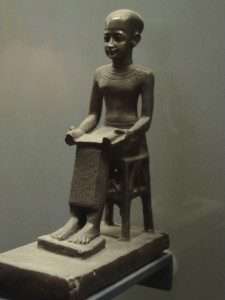
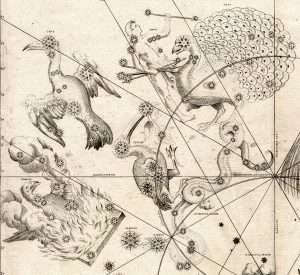
"Birds of a feather flock together." 'Skein' : "a length of thread or yarn, loosely coiled and knotted and/or: a flock of wild geese or swans in flight, typically in a V-shaped formation."
"Synchronistic example?: "There is one final element in this tangled skein of coincidence concerning my American trips. On the second visit i was taken by Paul, my host, to the top of one of the great Trade Towers...This was in 1989, track forward a dozen years to a 'ritual' in which i was taking part in London. Part of this consisted of a ritual officer taking up a stack of Tarot Trumps and placing them upon the 'altar', announcing the name of each one as he went. When he came to the 18th - the Lightening Struck Tower - it turned out to be missing. Where could it have gone? We had no alternative but to leave it out, and carry on reading the rest. In fact, the explanation was simple, it had stuck to the back of the card in front of it. But on my way home, i was surprised to find the trains packed with office workers. They said they had been sent home early because something terrible had happened in New York. The date was September the 11th - the Tower at whose submit i had been standing with my friend Paul - had been struck down. Coincidence? No doubt. But why do such coincidences as the missing card occur? For some reason it seems that on occasion strings are being pulled upon an inner level for purpose we cannot comprehend. Maybe just to remind us that strings and string pullers are there?" ['I Called it Magic'].
Question. Why 18th and not the 16th? {miss-print?}. Question 2. Try ''autopilot'' - think about it in relation to ''archetypes'' and Joseph Campbell's quote. A possibility or not?

"In Greek mythology, Memnon (/ˈmɛmnən/; Ancient Greek: Μέμνων means 'resolute'[1]) was a king of Aethiopia and son of Tithonus and Eos. As a warrior he was considered to be almost Achilles' equal in skill. During the Trojan War, he brought an army to Troy's defence and killed Antilochus, Nestor's son, during a fierce battle. Nestor challenged Memnon to a fight, but Memnon refused, being there was little honour in killing the aged man. Nestor then pleaded with Achilles to avenge his son's death. Despite warnings that soon after Memnon fell so too would Achilles, the two men fought. Memnon drew blood from Achilles, but Achilles drove his spear through Memnon's chest, sending the Aethiopian army running. The death of Memnon echoes that of Hector, another defender of Troy whom Achilles also killed out of revenge for a fallen comrade, Patroclus." Horemheb to enlarge.
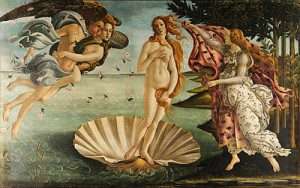
A beginning or end?
As seen from a different perspective..."Every culture in history - from pre-Biblical civilizations and inclusive of the ancient Greeks {whom we revere as the founders of Western civilization} - tells stories of an ancient, more perfect world. No war, no illness, no disease. Shangri-La. Atlantis. Then came some kind of 'fall' - a disengagement from the forces that bound us together in 'love' and 'happiness'. A separation. Some people attribute this event to the Garden of Eden. Some cultures attribute it to a time before that. With minor variations, this story is universal - locked in the collective unconscious of the human race, imprinted in our genes. To varying degrees, the Reconnection phenomenon takes us back, in our intrinsic memories , to this golden age, and ties us into our original sense of profound connection with all of life. Yet it is not simply moving back; its moving forward to something new as well. From this wholeness comes 'healing'. True healing. Evolutionary healing." [From the book by Dr E. Pearl].
'The Arthurian Formula' / D. Fortune + M. L. Brown.
Think about it in relation to such {archetypes?} as defined within this overall subject as a ''U-turn''. And 'love/happiness' in relation to the word ''grace''. Both of which are also... ''locked in the collective unconscious of the human race..."
And/or: "Furthermore, it was by no means the case that the whole of Atlantean culture was destroyed immediately after the great catastrophe; on the contrary, what remained was gradually 'carried over' and planted into the 'new time' {Aries?}. We will best understand the souls of the post-Atlantean descendants if we steep ourselves in the soul-life of the last Atlanteans." [Page 38, 'Egyptian Myth and Mysteries' / Rudolf Steiner].
And/or: ''The first post-Atlantean cultural epoch arose after the flooding of Atlantis, when the flood, which separates our culture from the Atlantean culture, had receded. The macrocosmic influence on that period was such that the force flowing through earthly life was the one corresponding to the rising sun at the vernal equinox in the sign of Cancer....'' [Page 80, same book].
Question. Right to left or left - right?
Question 2. What about the 'Micro' aspect?
That final link to J. Campbell's quote about a symbol being "energy evoking" - in relation to an 'end result' or final destination? OR both?
A practical [synchronistic?] example..."Shortly after film school i was elated to get into Art College to finally study a Fine Art degree...Unfortunately, both the experience of film school and art school were littered with an array of tough challenges. And although i was, at long last, pursuing my ambition of being an artist, i was steadily becoming a little worse mentally each day, aligning myself with a coterie of the wrong sort of people in London and setting myself up for a colossal fall." [Extract from the book by Q. S. Lam].
The author; who has no knowledge of this subject; identifies herself; or more importantly; those 'warring' [''wrestling'' link] - aspects of her ''internal self'' with Fred, Mia, and Sophia. Fred whom she feels to be a negative aspect of herself - could be identified with the Egyptian Set. Mia - more of a deva; with negative traits, could be identified with Nephthys. Sophia - 'the cloud catcher' - with Isis. And Horus; with the individual herself - just as Hatshepsut and Cleopatra did with their own 'male' aspect.
Side note: Arya Stark? {i.e., archetypal tomboy}.
Continued: Question. Is this subject therefore nothing more than a study in Psychosis? From the dawn of human kind?
'The Science of Kriya Yoga' : Chapter from the book 'Autobiography of a Yogi: Paramahansa Yogananda' ].
"It calms the dualistic turmoil by a divine inner certainty." Quote by the main character from the same book]. Question. What is being implied?
And/or..."Skilful meditation, healthy living, and realization of our 'Eternal Self' are the practices of Kriya Yoga..." [Back cover of the book 'Kriya Yoga' by Ryan Kurczak. Emphasis, this readers]. Think about it in relation to the 'divine bit'. Question. All illusional?

Mad, thoughtless or head nut?
Continued: "The allusions to Jesus and God during my psychosis were potent, which is strange since i am an agnostic and not at all religious {many psychotic episodes have these quasi-religious overtones}. Nietzsche was right: 'God is dead'. After psychosis, however, i wonder if there are other forces that come into play, an acute sensitivity of things that go unnoticed..." [Quote, by Q. S. Lam, including parenthesis].
Subject material? Try Dion Fortune to enlarge.
 And/or: "Psychology and esotericism set out to explore the darkness outside of our knowledge, whether it be dwelling in the 'unconscious' or the 'astral', the mundus imaginalis, or the dark side of the Tree of Life. Dion Fortune, whose life we shall examine further wrote: As soon as i touched the deeper aspects of practical psychology and watched the dissection of the mind under psycho-analysis, i realised that there was very much more in the mind than was accounted for by the accepted psychological theories. I saw that we stood in the center of a small circle of light thrown by accurate scientific knowledge, but around us was a vast, circumambient sphere of darkness, and in that darkness dim shapes were moving,{'astral' link}. It was in order to understand the hidden aspects of the mind that i originally took up the study of esotericism. In this small circle of light, surrounded by darkness, we are, as Plato says, ''strange prisoners'' and psychology and esotericism both seek the keys to our escape and restoration. " [Extract from the book 'The Magister'].
And/or: "Psychology and esotericism set out to explore the darkness outside of our knowledge, whether it be dwelling in the 'unconscious' or the 'astral', the mundus imaginalis, or the dark side of the Tree of Life. Dion Fortune, whose life we shall examine further wrote: As soon as i touched the deeper aspects of practical psychology and watched the dissection of the mind under psycho-analysis, i realised that there was very much more in the mind than was accounted for by the accepted psychological theories. I saw that we stood in the center of a small circle of light thrown by accurate scientific knowledge, but around us was a vast, circumambient sphere of darkness, and in that darkness dim shapes were moving,{'astral' link}. It was in order to understand the hidden aspects of the mind that i originally took up the study of esotericism. In this small circle of light, surrounded by darkness, we are, as Plato says, ''strange prisoners'' and psychology and esotericism both seek the keys to our escape and restoration. " [Extract from the book 'The Magister'].
"For just as no one comes to the Father but by Jesus Christ [John xiv,6], so does no one understand the Holy Trinity but by Mary-Sophia...And just as the Holy Trinity manifests itself through Jesus Christ, so understanding this manifestation is possible only through intuitive apprehension of what the above represents... " [Extract from the book by Tomberg].
 Those same keys used to define something- that inner something - that would be understood by those who understood the same [subject]. Curiosity to everyone else - and/or an ''unknown'' factor. But, once the spark is lit - that same curiosity that could lead to a deeper interest; a deeper interest that could lead to their own 'revelations'. That internalization that leads to a 'balance' - its that 'equilibrium' that is represented as a 'river' within a journey. Framework of . Mechanics of. Different authors expounding same; but from different 'angles' - from different start points. Very similar to the purpose of 'Oak Island'. Enlarged elsewhere.
Those same keys used to define something- that inner something - that would be understood by those who understood the same [subject]. Curiosity to everyone else - and/or an ''unknown'' factor. But, once the spark is lit - that same curiosity that could lead to a deeper interest; a deeper interest that could lead to their own 'revelations'. That internalization that leads to a 'balance' - its that 'equilibrium' that is represented as a 'river' within a journey. Framework of . Mechanics of. Different authors expounding same; but from different 'angles' - from different start points. Very similar to the purpose of 'Oak Island'. Enlarged elsewhere.
N.B. Gnosis = ''known,'' i.e., a known quantity. [Dictionary]. Try ''gnosis'' - purpose of.
Question. Nothing more than riddle makers? Hiding [or coming to terms] with an ongoing psychosis? Generation after generation?
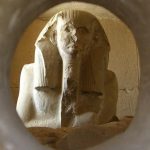
A 'vision' of Orions Belt? ''Three's''?
"Signs of psychosis are mania, rapid speech patterns, a fanatical zeal for order, frenetic work activity, flight of ideas, inability to sleep, amplified sounds, identification of patterns relating to numbers/people, [mainly family members], vivid disturbing visions, and acute paranoia. When full blown psychosis occurs, all the symptoms are woven together to create a seamless other universe, where only you have the messianic power and answers to solve the world's problems and crack the code..."
"...She was Bosnian and i was Bangladeshi and then i noticed the B's in Bosnia and Bangladesh and that if i inverted them they became the number three and that these B's in my life were actually 3's - were everywhere - and all these connections were profound and steeped in an allegorical divinity. Associations began to form, pulling all the strands of the code together..." [Q. S. LAM: Italics, this readers].

Spiral in shape.
Synchronistic link?..."At this point of revelation, Virgil, Dante's guide hitherto, the great exemplar of the heights of human intellect, poetic inspiration and magical power, disappears. He can take Dante no further. His instructor from henceforth, who now leads him through the heavens, is the great feminine power of 'divine' love. This is no theological or platonic abstraction, for she announces herself as a flesh and blood woman. 'Look at me well: truly i am, truly i am {B}eatrice', the girl whom Dante had loved in Florence." [From the book by G. Knight].
'Intellect' in relation {comparable?} - to 'gnosis' - by way of 'grace'? Hence...
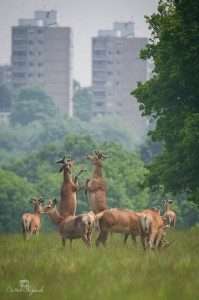 "In Dante's vision the masculine intellect, even at its highest and most poetic or 'magical' levels, can only go so far in the comprehension of reality, and that is to the external limits of the Earthly paradise. Therefore when Dante having traversed the deepest pits of Hell, and climbed the spiral path of Mount Purgatory, comes to the brook that circumscribes the Garden of Eden, he is able to go no further under 'Virgils' guidance. Virgil can only return to limbo, the noble but love-less state of the intellect, that can only see the world on its own terms and within its own limitations. To go further the force of 'love' is necessary. This force is embodied by Beatrice, who expresses not only mortal love, but carries the blinding, transfiguring power of divine love as well; that which created the 'worlds' and hold them in being. It is she who meets Dante at the limits of the earthy paradise and escorts him through the heavenly spheres to the limits of the UNcreate Empyreum {Ain Sof and/or daath/void link. Enlarged elsewhere} beyond the heavens. It is in fact she, the embodiment of the feminine principle, who is responsible for the whole Divine Comedy anyway, for it is upon her initiative that Dante, wandering lost in the dark wood of the world,{'intellect' only link} is given the opportunity to embark {i.e.,beginning of} upon his own tour of the inner conditions of the soul." [Same book. All emphasis, this readers].
"In Dante's vision the masculine intellect, even at its highest and most poetic or 'magical' levels, can only go so far in the comprehension of reality, and that is to the external limits of the Earthly paradise. Therefore when Dante having traversed the deepest pits of Hell, and climbed the spiral path of Mount Purgatory, comes to the brook that circumscribes the Garden of Eden, he is able to go no further under 'Virgils' guidance. Virgil can only return to limbo, the noble but love-less state of the intellect, that can only see the world on its own terms and within its own limitations. To go further the force of 'love' is necessary. This force is embodied by Beatrice, who expresses not only mortal love, but carries the blinding, transfiguring power of divine love as well; that which created the 'worlds' and hold them in being. It is she who meets Dante at the limits of the earthy paradise and escorts him through the heavenly spheres to the limits of the UNcreate Empyreum {Ain Sof and/or daath/void link. Enlarged elsewhere} beyond the heavens. It is in fact she, the embodiment of the feminine principle, who is responsible for the whole Divine Comedy anyway, for it is upon her initiative that Dante, wandering lost in the dark wood of the world,{'intellect' only link} is given the opportunity to embark {i.e.,beginning of} upon his own tour of the inner conditions of the soul." [Same book. All emphasis, this readers].
Side note: ''Florence Nightingale was the first non royal {'Noble'} woman to appear on a British banknote. She was named after the Italian City Tuscany, where she was born. George Stephenson being the first.''
And/or: ''The river Po rises in the Western Alps and flows East for 400 miles. It passess through Piacenza and Turin, before discharging into the Adriatic Sea. It is the longest river in Italy.''
Nile?
Something extra: ''Piacenza is a city in Italy’s Emilia Romagna region. In its central Piazza Cavalli are 2 equestrian statues and the medieval Gothic Palace. A copper angel rotates atop the bell tower of Piacenza Cathedral. The nearby Sant’Antonino Basilica has an EIGHT-sided tower and 17th-century frescoes, plus a portal known as Heaven’s Gate, with a rose window.''
Octave?

Hestia. Rivited chair?
''The Rolling 'Pin' is one of the earliest known kitchen utensils traced back to the Etruscans. Glass types were known as 'sailors charms' and HUNG in the ships cabin {poop deck?}. The French style version is made of wood without HANDLES....All used for rolling out pastry.'' ['Chase the Case'].
H/V?
Needle?
''Hestia was the virgin goddess of the hearth and the home. As the goddess of the family hearth she also presided over the cooking of bread and the preparation of the family meal. Hestia was also the goddess of the sacrificial flame and received a share of every sacrifice to the gods. The cooking of the communal feast of sacrificial meat was a part of her domain.''

Refresher: "As the Prophet says, 'There is a piece of meat in mans body - when it is in a good state, the whole being improves, and when it is in a bad state, the whole being falls apart. Be aware, that piece of meat is the heart." [Extract taken from chapter 14, 'The Secret of Secrets'].
A working example: Recall the meat boxes under the 'shelves' in the tomb of Tut.
''Mantle'' to enlarge.
Side note: ''Shortly after i met Bill Gates, Bill's dad asked both of us to write down on a piece of paper ONE word that would best describe what had helped both of us the most. Bill and i, without any collaboration at all, each wrote down the word FOCUS.'' ['Becoming Warren Buffett' ].
Refresher: The English word 'focus' comes from the Latin for 'fireplace'. ['The Chase' / ITV / 31.1.22].
However, as his 'suffering' wife explains - he had no idea's on the domestic front: ''He was not really well adjusted...He's a sort of a genius. I think that sometimes they are by default lonely and isolated...It was like having a moat around him, he didn't know who to let in.''
'Female' aspect to enlarge {in that inner sense of the word}.

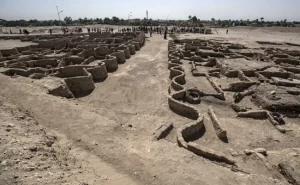
Many pots of meat found in the new city of the Dazzling Aten. Amenhotep III its creator.
"...What is to come is the core of the Mysteries of the Feminine Principle. It is akin to the awakening of the sleeping goddess in naked glory and splendour in the 'Chemical Marriage of Christian Rosencreutz. And also the appearance of the great goddess Isis...to the repentant Lucius the ass. Or to the 'sky walking' dakinas who are the consorts of the highest compassionate buddhas in the Tibetan system. Or to the source of the golden apples of the Hesperides - that were the key to the possession of the pure maiden huntress Atalanta. " [From the book by G. Knight].
N.B. As a side note recall the posture in the painting by Botticelli - i.e.,not sleeping. But awakened to something? Through study? Finally try ''Atalanta'' to define Oak Island - its intent and purpose - by the same method.
''The adjacent islands to oak island were known as ''apple'' and ''frog'' island.''

Question. What's he pulling? 'Handle' on the moment? First step or last one?
Side step: {in the 'myth' - story telling - sense of the word}: ''When Chekhov saw the LONG winter - he saw a winter bleak, dark and bereft of hope. Yet we know winter is just another step in the cycle of life. But standing here amongst the people of Punxsutawney, basking in the warmth of their hearths and hearts, i couldn't imagine a better fate than a long and lustrous winter.'' ['Groundhog Day' / 1993].
With: ''I think the last thing you heard: 'Only god can make a tree.'' {same}.
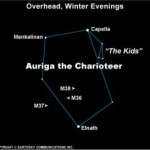 Refresher: "Psychology and esotericism set out to explore the darkness outside of our knowledge, whether it be dwelling in the 'unconscious' or the 'astral', the mundus imaginalis, or the dark side of the Tree of Life. Dion Fortune, whose life we shall examine further wrote: As soon as i touched the deeper aspects of practical psychology and watched the dissection of the mind under psycho-analysis, i realised that there was very much more in the mind than was accounted for by the accepted psychological theories. I saw that we stood in the center of a small circle of light thrown by accurate scientific knowledge, but around us was a vast, circumambient sphere of darkness, and in that darkness dim shapes were moving,{'astral' link}. It was in order to understand the hidden aspects of the mind that i originally took up the study of esotericism. In this small circle of light, surrounded by darkness, we are, as Plato says, ''strange prisoners'' and psychology and esotericism both seek the keys to our escape and restoration. " [Extract from the book 'The Magister']. Try ''strange/r'' and ''peculiar''. Preferably before those first impressions whisper something else.
Refresher: "Psychology and esotericism set out to explore the darkness outside of our knowledge, whether it be dwelling in the 'unconscious' or the 'astral', the mundus imaginalis, or the dark side of the Tree of Life. Dion Fortune, whose life we shall examine further wrote: As soon as i touched the deeper aspects of practical psychology and watched the dissection of the mind under psycho-analysis, i realised that there was very much more in the mind than was accounted for by the accepted psychological theories. I saw that we stood in the center of a small circle of light thrown by accurate scientific knowledge, but around us was a vast, circumambient sphere of darkness, and in that darkness dim shapes were moving,{'astral' link}. It was in order to understand the hidden aspects of the mind that i originally took up the study of esotericism. In this small circle of light, surrounded by darkness, we are, as Plato says, ''strange prisoners'' and psychology and esotericism both seek the keys to our escape and restoration. " [Extract from the book 'The Magister']. Try ''strange/r'' and ''peculiar''. Preferably before those first impressions whisper something else.
Something ''fallen'' {and/or ''asleep''} that once made aware of, becomes those familiar ''foundation stones''. Start point of.
'Theme' to enlarge.
Working example: 'Foundation for Mind Research' / J. Houston.
"...Possibly significant in this respect is that in the language of the Sumerians, who thrived on the Mesopotamia Plain from ca. 2900 BC to 1940 BC, the word for plancenta, 'us', is more or less identical to that used for 'blood' and 'death' {'us'}, as well as the word for 'base' or 'foundation place' {'us'} - as in a place to set up the central pole for a tent. Such a term might easily have applied to Gobekli-tepe, where the pole in question was represented by the enclosures twin central pillars..." ['Gobekli Tepe' by A. Collins]. Try ''womb'' as well as ''twin''.
"It is upon this unpromising foundation that Apuleius built a profound story of initiation into the Mysteries of Isis. When Lucius, the hero of the story, is turned into an ass, he falls into a semi-animal condition from a higher state of being. This is analogous to the Neo-Platonic idea of the human spirit falling into material existence...the subsequent adventures of the ass are thus parallel to the initiations of the Mysteries, that lead from the material world to the condition of the UNfallen state. [Extract taken from the book by G. Knight].


Levelling up: ''We don't want to concrete the countryside do we?'' Who put that idea in his head. His working colleagues or Rich builder friends? Public servant or just the 'rich man with detached house and acres of land one'? TEAM PLAYERS? BRITISH VALUES?
A working example: ''The soul is of course 'immaterial', and it is not only beyond matter but also beyond what is considered spirit: that is, it is beyond whatever the intellect, at its highest, can reach and understand or make clear to itself...The connection between the body and the soul is like what occurs at the end of a line of light, when a dark body is illuminated....The divine spark that is the soul thus vitalizes the human body....It exists in every individual being, hidden and veiled as a spark of a higher perception, of a superior aspiration, and touches the higher level which is Spirit.....Which is called the 'world of formation' {above the 'world of action'}....'' [Pages 55-57 'The Thirteen Petalled Rose' / A. Steinsaltz].
Shadow in relation to 'midnight sun'?
From a different perspective: ''Michael was finishing his doctorate in neurophysiology and had introduced me to several psychiatrists and physicians who had a special license to do LSD research. They had asked me to think about joining them in the study of the effects of the drug on human personality because of my familiarity with myth and symbol - ASPECTS OF WHICH WERE ALWAYS RECURRING in their research subjects and which their medical education had not prepared them for.'' [Page 173 'A Mythic Life' / J. Houston].
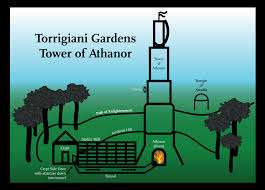
Locked/UNlocked? Mercurius?
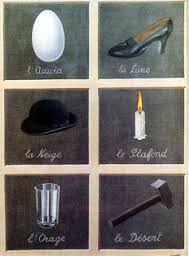
Ostrich egg?
And/or: ''For i suddenly knew that we all contain ''so much more'' than we think we do. The image came to me of a house {or temple?} with many floors, and i saw that in ordinary awareness we live on a shelf in the ATTIC of our selves {'kings' chamber?}, leaving the other floors relatively uninhabited and the basement locked. What furnishings and books, what interesting artworks and appliances....to be found in the rooms of the many -mansioned self. Treasure troves to be sure.....within the interior castle....Some once and future self woke up in me then and knew that i had no other choice but to pursue the path of Hermes, the trickster, and invent a career that would discover ways of tapping into that ''so much more'' of deep knowledge that WE ALL CARRY IN THE NESTED GNOSIS WITHIN.'' [Page 116, same book].
'Sycamore'?
'Mansion of Millions of Years' to enlarge.
Question. Kings chamber = attic? If so, what does that imply to the 'whole'?
And/or the shelfs in Tut's tomb.
'Mantle' to enlarge.

"Homelessness is a lifestyle choice." And/or: Anyone entering the UK illegally - out of desperation - has to be sent to Rwanda, yes, even though there record on Human Rights is in the RED - they have promised to correct this within 18 months. Question. Can bad habits be TURNED AROUND into good ones in a short space of time?. Are such opinions what they think they have to say to be acceptable? Or do they really think that such 'opinions' show off their British values? Mummy/Daddy values? IS THIS WHAT THEY THINK BRITISH VALUES ARE? Are such questions politically correct? Should they still be asked and accessed anyway?
REFRESHER: ''Many years ago, the English psychologist F.W.H. Meyer suggested that hidden within the depths of our being is a rubbish heap as well as a treasure house.''
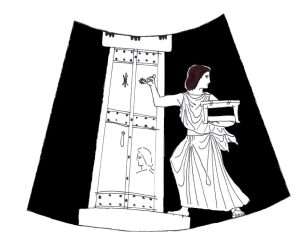
''Widen ones horizon.'' Attic or basement? ''As above so below.'' Khafre to enlarge.
Solomons keys / Laconian key to enlarge.
''We do know, however, that such keys had been in use since very ancient times; in Homer we hear of them:
“…she climbed the high
stairway to her chamber, and took the bent key in her strong hand, a goodly key of bronze, and on it was a handle of ivory...”
Bower.
That same link to Freemasonry and their 'equivalent' of the above... by way of, 'Solomon's Temple', and 'Hiram Abif'...with each member in mind. Explained within. That same link [by way of ''Freemasonry''] to the 'legend' of Oak Island. Purpose of. Notice its position [i.e.,Nova Scotia] relative to the ''Pillars of Hercules {and/or Heracles}.'' Together with its position in relation to the Equator and North pole. All in relation to a ''water mass.'' South in relation to North. East in relation to West. 'Wet' in relation to 'dry.' The start point of which becomes those two 'pillars'. As a representation of something. From something unknown ['wet'] to becoming known ['dry']. Representational of.
Finally Richard Wagners opera of three acts, namely 'Parsifal', of which he describes as..."not as an opera, but as a festival play for the consecration of the stage." That link to the 'Horns of consecration'. 'Wagners stage' and what is 'seen', becomes that equivalent...
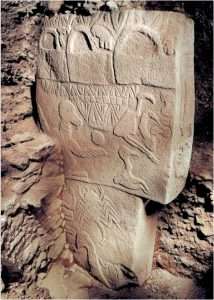
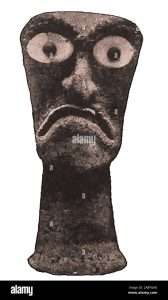
"Perhaps we may start by admitting that we are wounded {naked?}. ‘The metaphysician (is a) wounded man. A wounded man is not an agnostic — he just has different questions arising out of his wound. Like the shaman, the wounded healer is one who knows that the true cause of pain is loss of Inner reality — the Inner Kingdom. This realization fired the Gnostics to go upon their own voyage of discovery, just as it later inspired those who went on quest for the Grail and the healing of the Waste Land. Truly, there are many ways of achieving the Great Work." {Page 253 'The Western Way'}.
"The ancient mysteries were only sacred art - being in the background conscious of mysticism and gnosis. But after forgetting this background or, so to say, after this background receded too far into the background, there remained a gnosis [or a ''revelation''] deprived at root of mystical discipline and experience. In this way ''creative art'' originated, and the mysteries became theatre, revelationary mantras became verses, hymns became songs, and revelationary ''pantomimic'' movements became dances...The pure revelation of gnosis had become more and more a game of the imagination and the power of magic had degenerated more and more into aesthetics. Richard Wagner understood this and wanted to remedy it. The work of Wagner followed the aim of the reintegration of art - to effect reunion with gnosis and mysticism so that it becomes 'Sacred Magic' again." [Taken from within the book by Tomberg].
'Acrobat' to enlarge.
''Sacred'' in relation to 'top/down' - ''Magic'' in relation to 'bottom/up', [i.e., a potential to be realised]. Higher in relation to lower. The union of the two = a ''crossover'' point [or a 'connected-ness' of some description]. Always represented in whatever time-frame or culture [in part] as a u-turn.
Question. How would Wagner represent same - on a stage?
'Theo-Drama: Theological Dramatic Theory' by Hans Urs Von Balthasar.
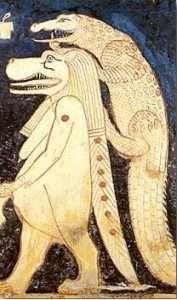
Which one 'remembers'?
Analogy of same?..."One day i entered a cinema house to view a newsreel of the European battlefields. The First World War was still being waged in the West; the news reel presented the carnage with such realism that i left the theater with a troubled heart. ''Lord'', i prayed, ''why dost thou permit such suffering?" To my intense surprise, an instant answer came in the form of a vision of the actual European battlefields. The scenes, filled with the dead and dying, far surpassed in ferocity any representation of the newsreel. ''Look intently!'' A gentle voice spoke to my inner consciousness. ''You will see that these scenes now being enacted in France are nothing but a play of chiaroscuro. They are the cosmic motion picture , as real and as unreal, as the theater newsreel you have just seen - a play within a play." My heart was still not comforted. The Divine Voice went on: "Creation is light and shadow both, else no picture is possible. [''Shadow/anima'' link? This readers input]. The good and evil of 'maya' must ever alternate in supremacy. If joy were ceaseless here in this world, would man ever desire another? Without suffering, he scarcely cares to recall that he has forsaken his eternal home [''fall'' link]. Pain is a prod to remembrance. The way of escape is through wisdom. The tragedy of death is unreal; those who shudder at it are like an ignorant actor who dies of fright on the stage when nothing more has been fired at him than a blank cartridge. My son's are children of light, they will not sleep forever in delusion." Although i had read scriptural accounts of maya, they had not given me the deep insight that came with personal visions and with the accompanying words of consolation. One's values are profoundly changed when he is finally convinced that creation is only a vast motion picture; and that not in it; but beyond it, lies his own reality." [Extract from the book on 'Paramahansa Yogananda' ].
Question. Has he seen to many 'Matrix' movies? Either way - besides looking up the those obvious 'highlighted' aspects - think about that final sentence in relation to Horus ''in/of'' the horizon. Begin in Part 1 - rather than leave - everything - to those first impressions.

Archetype?
From a different perspective: ''In magical lodges the techniques of pathworking {ie., 'visualization'} - is often used to lead the whole brotherhood {Freemasonry?} into a shared experience of 'another place' {archetypal?}, a sacred temple or 'center' of the wisdom they seek. All will share the 'visions', each 'seeing' his or her own interpretation of the images described, and it is in this 'Place between the Worlds' {'Akashic records'?} that a magic happening can be translated into a real event." [Page 49, 'Magic for the Aquarian Age' / M. Green].
Another example with the same intent; but now through research..."Drury's belief that the artist is a vehicle for; not a creator of, his artistic productions produced a desire to explore methods of charting the hidden sources of inspiration. 'The levels of inspiration achieved by different artists seems to me to parallel the stages of consciousness outlined in the Kabbalah, and for this reason, one of my main aspirations is to achieve greater rapport with the higher levels of my unconscious'. And so Skinner's need for scientific exactitude and Drury's desire to tap hidden levels of subconscious vitality combine in a common purpose. The first result of their cooperation appears in this far-ranging and highly readable book." Taken from the introduction to the book 'The Search for Abraxas']. Together with...
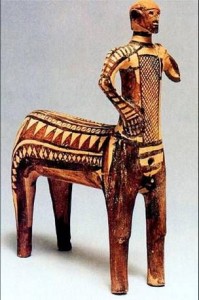
Lefkandi minotaur. Euboea. FIRST known depiction of mythology in Greek sculpture. An ''archon''? A man-horse one?

The patella (pl.: patellae or patellas), also known as the kneecap, is a flat, rounded triangular bone which articulates with the femur (thigh bone) and covers and protects the anterior articular surface of the knee joint. The patella is found in many tetrapods, such as mice, cats, birds, and dogs, but not in whales, or most reptiles.
In humans, the patella is the largest sesamoid bone (i.e., embedded within a tendon or a muscle) in the body. Babies are born with a patella of soft cartilage which begins to ossify into bone at about four years of age.....The word patella originated in the late 17th century from the diminutive form of Latin patina or patena or paten, meaning shallow dish.[13][14]
"This book is about levels of consciousness, and Western man's pursuit of the Ultimate level. There are many doctrines and methods leading to this Reality. We deal here with less familiar paths leading to that exalted state of Being, which we have designated Abraxas, because we find it meaningful. There are many other names we could have chosen. [Prologue to same book]. A beginning and end.
Try ''archon'' {all '365' of them?}. All 'year' round?
And/or: "As we shall see, the Gnostics and Mandeans left instructions for their initiates as to how they should leave the earthly sphere and progress through the spheres or levels of the Archons - the 'rulers' of the planets...." [Page 36 'The Western Way'. Vol 2].
As one OTHER example {that very first one?}: "The creation of Achilles shield is one of the most beautiful pieces of narrative in the Iliad, and, as Homer must have intended, it is not easily forgotten. The importance of the shield - which bears little resemblance to any shield ever used by earthly warriors - can be gauged from the 125 lines or so of narrative used to describe its features, but why the shield looked like it did is one of the epics mysteries.
'134'?

Team player or Dictator. For the Constitution or Trump Dynasty?

Destiny awaits? Written in the stars?
As with much else in the Iliad, an answer to this long standing mystery can be found in the heavens {authors hypothesis only}, and the need to create a new constellation in a previously undistinguished part of the sky to accommodate the return of 'brilliant' Sirius. There can be no better way to describe that area of sky by extended metaphor, using images not encountered elsewhere in the epic. Homer begins by associating the shape of the shield with the celestial sphere, upon which he places the Sun, the Moon, the Milky Way and a handful of stars - but NOT Canis Major, the eventual home of Achilles. He then goes on to describe wonderful decorations on the shield, including two warring cities, judges and disputing litigants, a wedding scene, reapers and binders, a vineyard and fallow land, cattle and lions, herdsmen, dogs and dancers. Not only has Homer identified the region of the sky in which the new constellation is to be created, but each scene of rural or town life is believed to describe separate parts of the sky which, when seen as a whole, encompasses the constellations now known as Canis Major, Canis Minor and Monoceros {i.e.,''another item of 'clothing' found in the sky is Achilles helmet, a group of stars in Monoceros, the modern constellation above the 'head' of Canis Major''}. Homer could not include these constellations in his opening remarks on the shield, for the shield had not yet been finished and the stars had not been described..." ['Homer's Secret Iliad']...

"YOU EXPECT SOMETHING BETTER FROM your PRESIDENT." During their efforts to overturn the results of the election, Trump and his ally Rudy Giuliani repeatedly claimed that Freeman and Moss had committed election fraud. A heavily edited, brief clip of security footage was widely circulated online and by Trump allies as supposed proof.{NBC News}. Fake news?

Gods man or the devils man? Could it have happened to a nicer person? Everything comes in threes? Ladbrokes taking any bets?
''Rural or town life'' in relation to : "In another vision i was a teenager living in France [South?], in a small village, and one day something special happened - there was a buzz of excitement in the village. The Floating City was coming! I knew this was my opportunity; i was stifled by the village atmosphere and, although i didn't want to stay on the Floating City, i knew that, if i could get aboard, i would be able to find out about - what ever it was i was looking for! I did get aboard - but i snapped out of the vision before anything else became clear.." [Enlarged elsewhere].
Question. Coincidence or a meaningful one?
''Floating island'' ?

''A land is only as good as its leaders." {'The Kid Who Would be King." / 2019}.
Question 2. ''Rural'' {feet?} ''Town'' {head and 'shoulders'?}. as a means...? The main point being - those unknown quantities can be worked out - OR AT LEAST as close to an end result as is possible - when subject material in ALL ITS PARTS are taken into consideration.
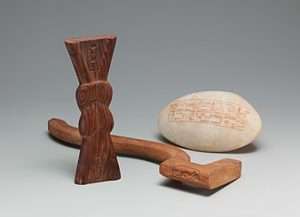
Games?
A working example: ''I've been lying here being an anthropologist on my own dying - fascinating experience, by the way; there is no hierarchy to it, and i've had an important insight into the future. The world is going to change so fast that people and governments will not be prepared to be stewards of this change. What will save them is teaching-learning communities. They could come together in churches or businesses or even in families. They could meet weekly and do your kinds of exercises, especially ones that develop their capacities. There must be humour, laughter, music, games and good food as well. That will keep the participants coming back....Then when they feel ready, they will choose projects to work on to help their communities.'' [Page 228 'A Mythic Life' / J. Houston].
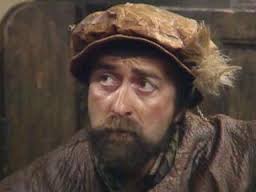
Hence: "First Hephaestus shaped the shield so great and strong, adorning it all over and binding it round with a gleaming circuit of three layers; and the baldric was made of silver. He made the shield in five thicknesses, and with many a wonder did his cunning hand enrich it. He wrought the Earth, the heavens, and the sea; the Moon also at her full and the untiring Sun, with all the signs that glorify the face of Heaven - the Pleiads, the Hyads, huge Orion, and the Bear, which men also call the Wain and which turns round ever in one place, facing Orion, and alone never dips into the stream of Oceanus'...That these words refer to the skies is not disputed by scholars, but no definitive reason has ever been given for the more unusual phrases...
Side note: Moses who attempted to ''see'' god 'face to face' - while recalling that in order to complete {and therefore begin a journey} one has to 'emerge' into the ''stream of Oceanus''...Try ''Oxen'' and/or ''vase/s''.
Question. ''Back of'' only? Therefore something of a ''northern'' perspective?
Refresher: "The ancient Egyptians...saw OSIRIS appear in the southern sky in the constellation of Orion, in the period immediately preceding the flood. But the flood itself was heralded by Isis...represented by the star Sirius, some time after the first reemergence of Orion from below the southern horizon...A person standing and facing south is the ''archetypal'' position by which the Egyptians orientated themselves in the ''Beloved Land'' {ta-meri}. One of the terms for ''south'' is also a term for ''face'', while the word usually used for ''north'' is related to a word that means "back of the head''. [Page 9 'Temple of the Cosmos' / J. Naydler].
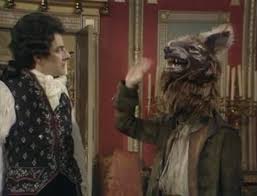
"The way of the fool is no easy way, for it involves a balancing act, in which the Fool may stumble, and become a fool. It is a cunning way - a way of strange knowledge. It is 'the Way that is Not a Way' - 'the Way that Cannot be Named' ..." ['The Zelator']. Question. The 'Trickster Way'??

Onions.
Continued..."Our proposed interpretation is that the 'gleaming circuit of three layers; and the baldric - made of silver' are the Milky Way, whose three layers are the bright central section flanked on both sides by fainter bands of light. The silver baldric is a metaphor for the way in which the Milky Way encircles the Earth, just as a strap fastening to a shield goes round the body of a warrior {authors hypothesis only}. Homer sets the scene in the northern hemisphere by naming the Wain {or Plough} in Ursa Major, and by identifying Orion, the Hyades and the Pleiades he uses three well known groups of stars to determine the region of sky into which Sirius is to be placed. The Milky Way runs from top to bottom close to Canis Major, but the significance of the 'five thicknesses' is not yet clear...Homer then changes his mood, introducing scenes quite different from ANYTHING ELSE in the Iliad, using images of rural and town life as metaphors for individual stars, groups of brighter stars, dark parts of the sky with few stars, and also the Milky Way...Enlarged elsewhere. {'Homer's Secret Iliad'].
Recall what 'five' represents within this subject material {as a whole}.
 And/or ''Clothing'' in relation to: "There's a great deal to be learned from these mediaeval images of the Fool. The mediaeval 'Feast of Fool' was of profound importance simply because it had esoteric overtones. Of course, you'll learn more about this, if we do a book together."...............'A book about the naked Mark Hedsel?'........He laughed. ''Partly naked - that is to say, a Fool, transformed by imagination.'' He emphasized the '{i}mage' of the last word." [Extract from the prologue to the book 'The Zelator' by M. Hedsel].
And/or ''Clothing'' in relation to: "There's a great deal to be learned from these mediaeval images of the Fool. The mediaeval 'Feast of Fool' was of profound importance simply because it had esoteric overtones. Of course, you'll learn more about this, if we do a book together."...............'A book about the naked Mark Hedsel?'........He laughed. ''Partly naked - that is to say, a Fool, transformed by imagination.'' He emphasized the '{i}mage' of the last word." [Extract from the prologue to the book 'The Zelator' by M. Hedsel].
Side note: {i} in relation to the word ''Ishon'' and/or 'The Waters of the Gap'...ALL as a means...?
Podrick? [Game of Thrones].


Saturn link?
SIDE NOTE: "Of course, scholars might argue that in this play with the word 'sal' we deal with linguistic traces from different etymologies. However, the fact is that in the earliest known Latin literature, Sal, besides denoting common salt, also meant 'cunning' and 'wit'. A good Fool was always a salty Fool, worth his salt. His salary was paid in recognition of his worth, and he was, in truth, no fool in the ordinary sense of the word...Tears contain salt, which is one of the high Mysteries of alchemy. In the arcane texts, salt is the residue of 'fire', just as salt tears are a residue of an inner emotional 'burning'..." Same book.
Question. What represents that ''emotional burning'' ?
'Fire on fire'? {Page 36 'Meditations on the Tarot'].
'Valley of Tears' ? What would a 'mountain' represent?

''That's what I saw in the fire. A mountain looking like an arrow head." ['Game of Thrones' {the Hound}. Series 7. Episode 6. 'Beyond the Wall'].
'Feast of the Tail' ?
Male/female = shadow/anima? OR is it animus? i.e.,from a female perspective in that Matriarch society that supposedly predated the Patriarchal one?
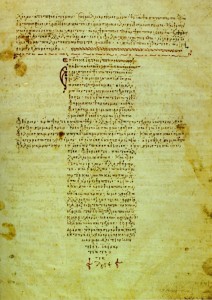
Hippo-cratic Oath.
A working example {i.e.,a coming together of Animus - Anima . The very first one?}: "In the oldest tales there are references to the beautiful third Gorgon sister, Medusa, who willingly takes the Sea God as her lover in the celebration of the 'sexual' mysteries of the Goddess and her Consort. After a certain point after 2000 BC the legends tell of the 'marriage' or alternative 'rape' of Queen Medusa to the oceanic King Poseidon, one of the original Olympians, who had been known in his earlier form as Hippios the horse deity as well as lord of the sea. Poseidon in the form of a stallion mounted Medusa as a mare and fathered Pegasus, a winged moon horse. An early representation of Medusa, dating from the 7th century BC in Boeotia, shows her as a small, slender mare-woman who, although masked with a Gorgon's head, shows none of the frightful aspects of the classical Gorgon. By associating the Gorgon mask with the slender equine form, this artist permits us to catch a brief glimpse of a far more ancient tradition, in which the dark sister was not an isolated object of fear. The Gorgon mask, as the face of the moon, suggests that Medusa was one of the three aspects of the pre-Hellenic Moon Goddess., and the small native horses of these indigenous peoples were sacred to the early moon cults in rainmaking ceremonies. Poseidon's rape of Medusa in the form of a stallion tells the story of how the first wave of invading Hellenes, from Greece, who rode large, vigorous horses, forcibly married the Amazon moon priestesses and took over the rainmaking rites of the sacred horse cult through the 'birth' of Pegasus." [Page 162 'Mysteries of the Dark Moon']. Question. Why the horse?
N.B. Hippo in Greek means horse.
Khal Drogo / Daenerys Targaryen? {Game of Thrones}.
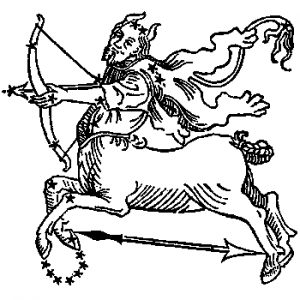
Sagittarius = 'Half man/horse. Coincidence or a meaningful one? ''Healing'' link?
Side step: "Small figure found as part of grave goods on the island of Euboea {lefkandi}. Half man, half horse - the first known depiction of mythology in Greek sculpture. It begins the development of Greek art over the next few centuries. It combines geometric patterns with a passion for mythology...This fascination with patterns will lead Greece out of the Dark Ages." ['Treasuries of Ancient Greece'. Enlarged elsewhere].
"Its the first public sculpture in Britain - a large horse on an Oxfordshire hillside 3000 years ago. The hill - a border crossing - it was hotly contested {by at least three tribes}. Hill figures found no where else in Europe. This one marks a key moment in the development of British identity...The people who lived here were marking their lands with a tribal emblem / logo..." ['Seven Ages of Britain' . Mentioned elsewhere]. Coincidence or a meaningful one?
Question. Tribal only or subject material? IF subject material - which came first - landscape or subject AND why?
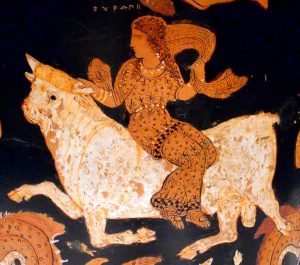 " Originally, Libra and Scorpio was one house whose sign was the claws of the eagle, but eventually these houses divided. In the Epic of Gilgamesh, the Scorpion gods of Mashu guard the entrance to the Underworld. Mashu was a magic mountain forming a boundary between the houses….Sagittarius is ruled by Bel, who in this house is the god of cattle. Enkidu, half man, half bull was the first representation so it is fitting for its sign to be the centaur with an arrow...." [Page 47 'Pathway to the Zodiac'].
" Originally, Libra and Scorpio was one house whose sign was the claws of the eagle, but eventually these houses divided. In the Epic of Gilgamesh, the Scorpion gods of Mashu guard the entrance to the Underworld. Mashu was a magic mountain forming a boundary between the houses….Sagittarius is ruled by Bel, who in this house is the god of cattle. Enkidu, half man, half bull was the first representation so it is fitting for its sign to be the centaur with an arrow...." [Page 47 'Pathway to the Zodiac'].
''houses divided'' = an 'evolution' of 'subject material' {in the spiritual sense of the word}? As with {as one example} the construction of Stonehenge centuries {500?} between its eventual construction - especially what was began externally to be placed internally. Outer/inner. Link to the Phoenix myth? something {evolving?} every 500 years.
Try ''chicks''.
''As though of lowing cattle''. A quote made from the Odysseus as narrated by Simon Armitage. Only '50' men remain from the original '600' as they come across an island of 'cattle' - on their ''return journey'' back home. Forbidden to eat and yet eaten if only by his men. Fate intervenes {'unlucky' link} - but the journey continues if only for the main character. All else just aspects of his 'lower' nature.
Side note; 500/600/800 - what do they all represent?

As part of that ''ancient mystery wisdom''?
"The ancient art of the mystery centers is ever healing, for it pertains to the true art which mirrors the spiritual realm. The art of San Miniato al Monte is perhaps the last complete representative of 13th century mystery wisdom, and it therefore requires that we approach it in a new way, with a view to receiving from it a much needed power of healing....There was a time when all art was concerned with linking man harmoniously with the 'spiritual' realm. The main purpose being - be it through music, words, dance or painting - was to bring healing and solace to the 'soul'...If the following text helps one person to a greater understanding of the ancient mystery wisdom...then all my years of labour and research will not have been in vain." ['The Secret Zodiac'].
Try ''Galactic Alignment'' to see what the author has not as yet seen.
''But to that one star-fish..." Eddie Murphy quote ['Holy Man'].
Analogy {when compared: wisdom found within?}: "In Chapter 4 we will further see the connections between the Queen of the Underworld and the King of the Sea. The fate of the Child and the Foal...The Otherworld {'Underworld'} 'malignancy' manifests as a 'claw' on May Eve, Beltaine, one of the Celtic fire - festivals and a day on which the way between the worlds is 'open'. These FORDING - PLACES {another being Samhain} - were marked by games and festivals....The 'claw' is reminiscent of the worm Grendel, which Beowulf fights...." [Page 29 'Mabon and the Mysteries of Britain'].
And/or: "The Pheryllt, according to whose ritual she {Keridwen} proceeded, are frequently mentioned by the Bards of Wales, and an old chronicle, quoted by Dr. Thomas Williams, states that the PHERYLLT had a college at Ox{ford} prior to the foundation of that university." [Douglas Monroe].
Try ''ford''. As a means...?
And/or: Claws in relation to tail. Especially in the 'constellational' sense of the word.
Feast of Fools?
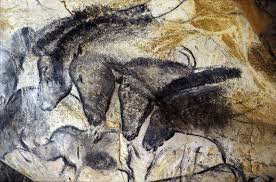
Enlarged elsewhere.
Side note: "The esoteric lore of the early Christians, formulated in the days when such words as 'resurrection' and 'reincarnation' had very different meanings from the ones ascribed to these words {concepts?} today, is also reappearing in many new 'esoteric' lores, legends and {other forms}, not all of which are of obvious value at the moment....Not just in philosophical concepts or literature, but in forms of art, or in games such as chess, playing cards and as {Stierlin has shown} even in such materialized sport as polo...The horse has ever been an esoteric symbol for the higher potential for thought, as Jonathan Swift, one of the great masters of the Green Language was aware, when he gave us the 'talking horses'..." ['The Secret Zodiac'].
'Mans Search for Meaning' / Viktor Frankl.
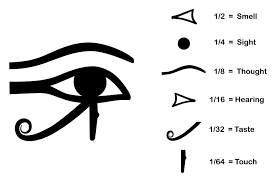 And/or: ''If eight is already a lucky number, connected with eternal beatitude and bliss, how much more its 'second power', 64 must be. 64 is always related in some way to play and fate. According to ancient Indian doctrine, a man should master sixtyfour different arts, and there are also sixtyfour different arts of loving taught in the Kamasutra: 'Combinations of the 8 kinds of embraces, kisses, ...of couplings....there emerges {on a higher level? i.e., octave link}, 8 groups of 8 that is 64.'...One also speaks of the 64 pleasures of Shiva, as if the 16 {sixteen} so important as the number of fullness and perfection {16 steps of Tut?}, were reflected in a fourfold mirror. Since sixtyfour is the number of play and gambling par excellence, it is not surprising that the chessboard, which originated in India, should have 64 squares.'' ['Mystery of Numbers'].
And/or: ''If eight is already a lucky number, connected with eternal beatitude and bliss, how much more its 'second power', 64 must be. 64 is always related in some way to play and fate. According to ancient Indian doctrine, a man should master sixtyfour different arts, and there are also sixtyfour different arts of loving taught in the Kamasutra: 'Combinations of the 8 kinds of embraces, kisses, ...of couplings....there emerges {on a higher level? i.e., octave link}, 8 groups of 8 that is 64.'...One also speaks of the 64 pleasures of Shiva, as if the 16 {sixteen} so important as the number of fullness and perfection {16 steps of Tut?}, were reflected in a fourfold mirror. Since sixtyfour is the number of play and gambling par excellence, it is not surprising that the chessboard, which originated in India, should have 64 squares.'' ['Mystery of Numbers'].
''Never mate with Knight on F8 is a mantra in chess.'' ['The Chase'].
Side note: Golden sandels found on the person of Tutankhamun.
'Mount of Beatitudes'?
''She Who Loves Silence''?
Side note: The 'four faces' of Hathor on columns at Dendera. [Pages 110/111 'Egypt's Anointing Mysteries' / A. Roberts].
And/or: ''I 'aint got nothing but love babe, - eight days of the week.'' ['The Beatles'].
N.B. For an example of landscape equivalent {Mayan} see 'The Eight Temples' within chapter 6 of the book 'Serpent of Light Beyond 2012'.
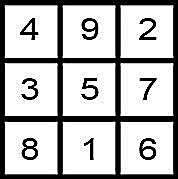
''The Celts used periods of darkness such as night and winter to begin their calculations of time. This meant that the first period of time in a "week" was a night, followed by a day. Further, they also counted the ending night period, giving rise to periods of time with more nights than days. In Irish, the term nómad is used to signify a small number of days and is exactly the length of the nine night week as in co cend nomaide – a period of time with nine nights divided nicely into a sidereal month of 27 nights. In Welsh, the word for "week" is wythnos which literally means "eight-nights" since it was historically considered that a week started and ended with a period of night bracketing seven days. Similarly the word for fortnight, pythefnos, literally means "fifteen-nights".[3][4]
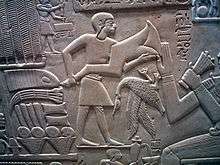
Thigh bone? Hindquarter?
Continued: "Life is like a chess game {'knight'?}. Each time a move is made, all sorts of other possible moves become available. Life is the same: change any tiny aspect and the whole future pattern could be radically altered. It is in this way that Will can be used to overcome or avoid ill luck....Man has free will - he can choose what path he takes..." [Page 75 'Magic for the Aquarian Age' / M. Green].
Recall the 'wooden horse' that decided the outcome {fate?} of spirit/'shadow' {Trojan?} and soul/'anima' {Greek?}. 'Helen' the common link between the two - as a means {method} to 'tell a story'. Before a 'return' journey became possible. Enlarged throughout. Coincidence or a meaningful one?
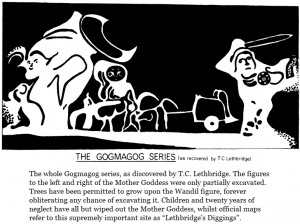
'Running Up That Hill': Kate Bush. Question. Hooked beak? Coincidence or a meaningful one?
Side note: Neil Oliver talks about the ''oldest artwork ever found in Britain'' found in a 'valley of caves' in Sheffield 13000 years ago. Fragment of horse bone {thigh?} with a sketch of a horse - galloping, In motion - ''that could be never more active and alive. Its miraculous.'' Other firsts {of horse carvings/effigies/symbols of same} elsewhere. All as a means....?
'Mountain Low. Valleys High'?
Static/dynamic?
The Square of Pegasus?
Other animals found in same cave including an Ibis bird with a 'curved beak'.
Question. Is the Ibis bird native to Sheffield. Has it ever been?
Try ''hooked'' for something beyond ''the need to identify with animals''.
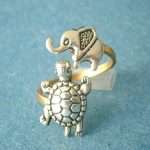 Side note: Glaciers {the 'creators' of hills/valleys} move 'backwards' northward from a southern perspective - in more {pleasing'?} warmer climates {'phases'?}. Caves exposed. The flood waters released moving in the opposite direction. Fresh water creating {'reflecting'?} lakes or 'meandering' rivers or mixing in with the salty sea. A process beginning or ending? Above or below the ''frost zone'' ? {5:9}.
Side note: Glaciers {the 'creators' of hills/valleys} move 'backwards' northward from a southern perspective - in more {pleasing'?} warmer climates {'phases'?}. Caves exposed. The flood waters released moving in the opposite direction. Fresh water creating {'reflecting'?} lakes or 'meandering' rivers or mixing in with the salty sea. A process beginning or ending? Above or below the ''frost zone'' ? {5:9}.
Question. At what stage {time?] of that retreat 'back to the 'north - was that cave in Sheffield exposed. Could a group of individuals - wanting to ''evolve'' their beliefs have followed that last glaciation as far as they could? Generation after generation. All 'members' sharing the same beliefs. When were these islands first known as those at the ''back of the north wind''? Where did the likes of Hesiod or Homer or Hecataeus of Abdera {a Greek living in Egypt} get there 'ideas' from? Oral tradition?
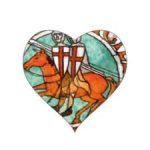
Mr Ed the ''Talking horse'' ?
REfresher: "Some of the most interesting work upon Palaeolithic art has been that of Steven Mithen, who has regarded it as a store of information about animals that were difficult to find or to stalk. Thus, reindeer and most birds were portrayed relatively seldom because they were abundant and easy to kill. Some of the abstract designs, he suggests, are actually hoofprints, sometimes drawn in association with a picture of the animal to which they would belong... Likewise, the reason why animals are only partially portrayed {i.e.,in profile; therefore an aspect of something - i.e.,of the lower half?} - could be because a stalker would only partially see them: this would explain why horns and antlers in particular are often shown by themselves or oversized. Now, much of this argument is splendidly perceptive. But it does not explain why most of it has to be shown hidden deep in caves, nor why so much is geometric, nor why particular animals should be paired or superimposed..."
Refresher: The symbol of the lower will is the altar {'cave'?}.
Side note: Everything in Tut's tomb was also oversized.
Symbolic intent only? Enlarged throughout!
To begin with try ''hunter'' in relation to the ''hunted''.
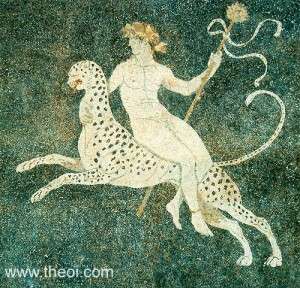
Panther or horse - or does it matter? As a means...?
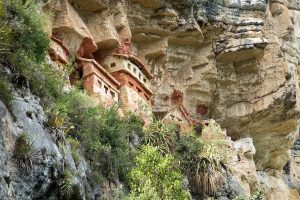
Mausoleos de Revash. Chachapoya.
Continued..."Scholars have always differed in their opinions as to the significance of this great body of work, for much of the present century there was a majority view that this art was an aid to 'hunting magic', i.e.,animals were represented in art and ceremonies performed around these figures to ensure of a successful hunt. Such a theory should not have survived the work of Peter Ucko and Andree Rosenfield, published in 1967. They pointed out that the animals represented in art did not really match the diet of the artists, as suggested by the bones left in their living sites. Thus reindeer and birds were often eaten but seldom painted or carved. Mammoths were rare at the time and place of the artists but were often painted.
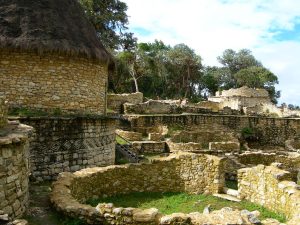
Kuelap.
The beasts most often painted were bison {oxen?} and horses, which were certainly hunted but not in a quantity to justify such a predominance...nor does it explain why structures such as that at El Juyo {'religious cave sanctuary'} should have been made. The assumption that herds of horses and bison were scarcer than those of reindeer, and less easy to kill {en masse}, is not sufficiently confirmed by the evidence at an earlier period, i.e.,hunters had stampeded a total of 10,000 horses over a cliff at Solutre, in France. At this stage of research, it seems wisest to suggest that the people of the Palaeolithic produced art for at least as many different reasons as the hunter-gatherers of the modern world...We lack the means to translate the artists message." ['The Pagan Religions of the Ancient British Isles'].
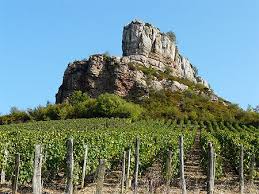
The Rock of Solutre. A limestone escarpment - surrounded by vineyards {S/E?}. Question. What aspect of the individual {'God'?} is represented by a ''vine''? Question 2. Why?
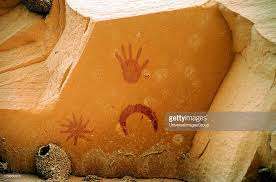
Precipice? Above or below the clouds?
"The Palaeolithic site of Solutre and the escarpment which protects it from the N/W winds are located a few miles west of the modern city of Macon, at the southern gate of Burgundy where roads - and probably prehistoric trails as well - from the Paris Basin to the north, Belgian to the N/E, and Germany to the east, CONVERGE before entering the Saone-Rhone corridor toward the Mediterranean...From the time of its discovery to the present, the research at Solutre has paralleled the development of the field of Palaeolithic prehistory....The massive accumulation of horse bones to the side of the escarpment, and unique in the archaeological records has baffled both archeologists and the public alike. "
As seen from a different perspective {that very first one?}: "We think the KEY that opened the door to all her following successes was found when her eyes was drawn to the region of the Bay of Pegasus, a large bay on the eastern side of mainland Greece to the North of the island Euboea, while studying a map. She took the bold but simple step of assuming that the bay, together with an ancient dried out lake and a pattern of towns to the north, was associated with the outline of the constellation of Pegasus...She then turned to the Catalogue of Ships. Of the region surrounding the Bay of Pegasus, Homer says the regiment of men came from..." ['Homer's Secret Iliad']. Enlarged elsewhere.
Try ''Harbour'' as a means...?
"The harbour on the lake was in fact richer than that on the sea" Strabo in reference to the 'Kibotos' canal.
Question. Was Strabo a member of any ''mystery club''?
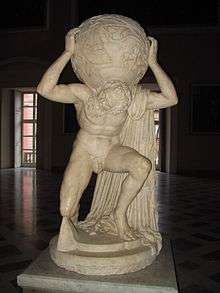
What would the remedy be for such a weight ''upon ones shoulders''?
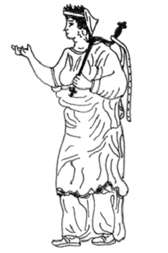
left shoulder?
Refresher: "I support my thesis by the existence, until a few years ago, of another sacred shoulder-blade of Pelops in the precinct which his great-grandson Hercules built in his honour at Olympia. Now, according to the myth, Pelops had only one sacred shoulder-blade, the right one; yet nobody has ever questioned the genuineness either of the relic at Olympia or of the Palladium. The history of the Olympian blade is this. During the siege of Troy the Greeks were told by an oracle that the only offensive counter-magic to the defensive magic of the Palladium preserved in the Citadel of Troy was the shoulderblade of Pelops which a tribe of Pelopians had taken to Pisa in Italy. So Agamemnon sent for the thing, but the ship that was bringing it to him went down off the coast of Euboea. Generations later, a Euboean fisherman dragged it up in his net and recognized it for what it was—probably by some design carved on it. He brought it to Delphi and the Delphic Oracle awarded it to the people of Olympia, who made the fisherman its pensioned guardian. If the bone was the shoulder-blade of a sacred por¬ poise, not of a man, the difficulty of Pelops's having had more than one right shoulder-blade disappears. So does the difficulty of believing that when boiled and eaten by the gods he came alive again—if the fact was that a new sacred porpoise was caught and eaten every year at Lusi by the devotees ofDeo. Does all this sound reasonable?"
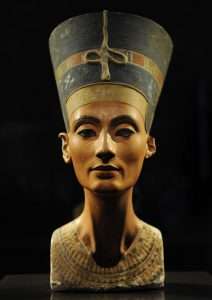
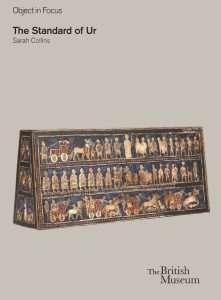
Also found near the neck.
A side step?..."Every year, pilgrims from every part of Egypt streamed into Abydos for the Feast of Osiris to witness a sacred seven day mystery pageant, a re-enactment of the life, death and resurrection of the god. It climaxed with a great battle between Horus and Set, which Horus always won."[Page 5, 'Omm Sety's Egypt by Hanny el Zeini and Catherine Dees].
Side note: "The hebdomad is the only number within the decad {apart from the monad} which neither generates nor is generated by another number within the decad; hence it is called by Pythagoreans ''virgin, not born of mother''.....Moreover, the hebdomad consisting of the dimensions and the four limits makes manifest corporeality and organic life. The limits are point, line, plane, solid; the dimensions are length, breadth, depth." [Page 186 'Alexandria' Vol 3. / D. Fideler].
Continued: Osiris who was 'killed' by his brother Set on the banks of the Nile at Abydos. Who then took his 'Throne'. More importantly, indicative of Osiris not able to advance beyond that u-turn in a 'river'. Horus, however, has to, in order to 'avenge' his 'fathers' death. Once avenged, then he can 'unite'. Clue... 'Hamlets Mill' in relation to what was found at Dendera. As an example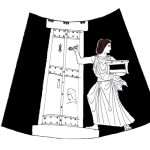 ..."All of these sources and influences appear in various guises within al-Arabi's works [in relation to the different 'aspects' learnt from different 'cultures' but all relate to that overall subject] where they become grist to the mill of his own unique enunciation of a vision of the Oneness of Being." [Introduction, 'The Bezels of Wisdom'. Mentioned elsewhere].
..."All of these sources and influences appear in various guises within al-Arabi's works [in relation to the different 'aspects' learnt from different 'cultures' but all relate to that overall subject] where they become grist to the mill of his own unique enunciation of a vision of the Oneness of Being." [Introduction, 'The Bezels of Wisdom'. Mentioned elsewhere].
'On Having No Head: Zen and the Rediscovery of the Obvious' / D. E. Harding.
Refresher: "Got to see it, rather than just read it..." John Humphrys talking to D. Tennant and Greg Doran in relation to the plays by W. Shakespeare. [400th anniversary. Radio 4. 23/04/16].
"The true voyage of discovery, lies not in seeking new landscapes, but in having new eyes." Marcel Proust.
Practical example: ''Say what you see'' {'Catchphrase' / ITV}
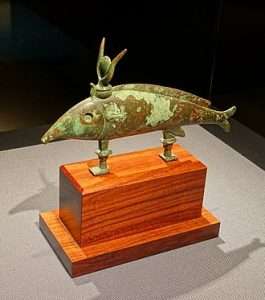
The 'fish' that ate the {'lost'} part of Osiris. 'Sharp nosed''. 19th Nome. Hooked? Put those ''neters'' together to 'see' something ''other than the obvious''.

Big man, Little phallus?
"The festival culminated in a procession at the head of which was carried a huge image of the phallus, representing the lost organ of Osiris. This was preceded by a vase of water, symbolizing the 'fertilizing' moisture of the moon, which is 'both' Osiris and Isis. The bowl [or 'cauldron' and/or 'cup' etc,] and the phallus are the eternal symbols of regeneration...And so year by year, the mysteries were exposed, the bowl, which is Isis, Mother, vase of life, and the Phallus, which is the fertilizing {'fire'?} power of Osiris - lost and found again. As these inanimate objects were solemnly carried in procession, they silently proclaimed the eternal verities which might be read and understood by those who had eyes to see. Through the truth that was thus ''shown forth,'' those who could understand might themselves partake in a new life which should be ever renewed like the life of the Ancient and Eternal Moon."[Chapter 13' of the book, by Esther Harding]. Try ''phallic{us}.''
"To prick ones conscience."
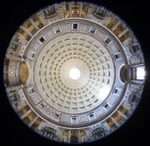
Occulus. ''Afar''?

Eye of Horus. ''Line of Sight?''
Refresher: ''Hesiod does not say much about the birth of Aphrodite. When Saturn castrated Ouranos and threw the severed phallus over his left shoulder, he was ridding himself and his mother of something intrusive, oppressive, unwanted {'swallowed' down link}. The idea that Aphrodite grew out of this castaway phallus {soul aspect of 'fire'?} of the 'father' lends a very deep mystery as to who she is and her place in the scheme of things. In the Zeus religion, she is thought to have come from very far away in order to join the Greek Pantheon.'' [Page 29 'Daughters of Saturn' / P. Reis].
Airborne?
'Widening'?
Side note: North of the Step Pyramid; at its lowest level - within a shaft {Osiris shaft?} - was found one solitary {complete} clay earthenware vase - after all the {broken?} bits and pieces {cups/bowls/vases?} were cleared.
Question. Fired or UNfired? Try ''cup''. And/or Aquarius. All as a means...?
Blue fired tiles found on its West side. ''Around the time of the 3rd dynasty''. ['Lost Mummy of Imhotep'].
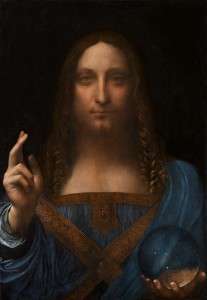
Salvator Mundi. Rock crystal in left hand. Coincidence?

Someone's New Name.
"Rock crystal was used not only for arrowheads but also for vases, the fabrication of which raises a problem as yet unsolved. Even if the exterior polish can be explained, the hollowing of potbellied crystal vases - several examples of which were found at Saqqara - remains incomprehensible. Likewise the procedure involved in making of the extremely thin and perfectly spherical crystal vase found by Zaki Saad at Heluan." ['Sacred Science'].
Try ''crystal'' and ''potbellied'' - all as a means...?
Side note: In the tomb of Tut a 'dagger' made of 'iron' from the stars. The pommel of which - ''made from rock crystal''. Found on his abdomen. ['Tut's Treasures: Hidden Secrets' / Nat Geo].
Left leg weakened - like one of the main characters in the Iliad 'story'. Something beginning? Feet/hands as a means....?
Gobekli-tepe = ''Navel of the Hill''.

''The reverse pattern of the flag of Switzerland is the flag of the Red Cross.'' ['The Chase'].
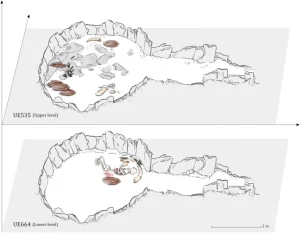
Even though Copper Age funerary practices in Iberia are largely characterized by collective inhumations, burial 10.049 at Valencina yielded the remains of a single individual interred as a primary inhumation (Fig. 2). This burial is remarkable for several reasons33,34. The individual buried in it was first identified as a probable young male between 17 and 25 years of age at the time of death based on standard anthropological analysis35. Strontium isotopes showed this individual to be of local origin, while at the same time, strikingly high levels of mercury in the bones revealed intense ante-mortem exposure to cinnabar36. This person was accompanied by a lavish set of prestige goods that included a large ceramic plate (in which chemical traces of wine and cannabis were found—Personal communication by Nicolas Garnier and Elisabeth Dodinet), a small copper awl and multiple flint and ivory objects (Fig. 2: lower level and Fig. 3). Remarkably, amongst the latter was a full tusk, weighing 1.8 kg, of an African elephant, which is unparalleled in western Europe37,38. Sometime after this burial, another offering was made to the individual buried in tomb 10.049 (Fig. 2: upper level and Fig. 4): a set of flat slate slabs were carefully laid above, and further grave goods were then deployed, including several large ceramic plates and many more ivory objects. Among the latter, a beautiful dagger with a blade made of rock crystal and an ivory handle decorated with 90 perforated discoid beads made of mother of pearl stands out.
A work in progress: ''In the winter of 2013 amateur geologist and expert crystal hunter Heinz Infanger was skiing in the mountains of central Switzerland's canton of Uri, when he came upon a rich vein of rock crystal exposed by a retreating glacier. Antler tools, wood fragments and rock crystal artifacts found....Hunter gatherers living during the Alpine Mesolithic period {9000-5500BC} had visited the site as recently as 5900BC and extracted rock crystal, after which it was covered by the advancing glacier. The closest known Mesolithic encampments are a two days trek away.'' ['Archaeology' Sep/Oct 2022].
Sheffield to enlarge.
Any 'crystals' found on the Amesbury archer?
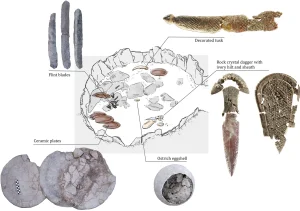
A complete African tusk {made of dentine i.e., teeth link} was placed at the Ivory Lady's head when she was first buried. At some point thereafter {up to 200 years}, slate slabs were carefully laid above her grave and a second collection of grave goods were placed on top. These new offerings featured an Asian elephant tusk carved with diamond shapes, a rock crystal dagger with an intricate ivory handle inlaid with 'ninety' marine shell beads...a patterned sheath for the dagger {lozenge?} and a nearly complete ostrich eggshell....This second set of offerings were made at the same time the women were interred in the Montelirio Tholos. ['Archaeology' / May-June 2024]. "Serpent hands" to enlarge.
A work in progress: ''Samples from the Stonehenge bluestones fall into two groups: the first comprise the very few that have been taken directly from the blue stones themslves {orthostats}. The other much larger group contain the many thousands of small pieces - the so called debitage - that litter the Stonehenge landscape. Demonstrating that fragments from this latter group belong to a given orthostat and are not random rocks, or even GLACIAL erractics, has been and continues to be a challenge.'' [Page 46: 'Archaeology' / October 2022].
And/or: 'In order to be able to speak of any kind of future life there must be a certain kind of crystallization, a certain fusion of mans inner qualities, a certain independence of external influences..'' [Page 655/877 {Kindle} 'In Search of the Miraculous' / P. D. Ouspensky].
All as a means.....?
And/or: "The human heart and the Notion of the Heart of god in the religion of ancient Egypt is described in the following passage: 'In their hieroglyphs - sacred writing where the image of the thing itself often represents the very word that designates it - the heart was none the less depicted only by an emblem: the vase. Is not the heart of man in fact the vase in which his life is continuously maintained by means of his blood?' It is this vase taken as symbol of the heart - which makes us think of the Holy Grail, the more so because in the case of the Grail...we see also a relationship to the Heart of Christ..." [From the chapter entitled 'The Sacred Heart and the Legend of the Holy Grail' from the book 'Fundamental Symbols' / R. Guenon].
'Heart' in relation to 'center'. A centering of something. As a means...?
Working example: ''Her two eye sockets are roughly symmetrical {'ears' are not}...The right eye is created from a ball of black coloured wax placed in the white-painted eye socket and covered with a thin lens of rock crystal engraved with the outline of the iris. The left eye contained no eye or pupil...'' [Page 114 'Nefertiti's Face' / J. Tyldesley].
Question. Beaker burials? {'Digging for Britain' . Series 1. Episode 2].
Try ''Mandala'' for a different take on the same theme.

Ganymedes? Question. Why do the 'survivors' of the 'struggle' of Troy find themselves being represented as the beginnings {foundations?} of different civilizations? AND/OR: "Geoffrey's line of alleged kings begins with Brutus, who settled in Britain in the aftermath of the Trojan War....It is in the 'History' that King Lear enters literature, and it is in the 'History' that Merlin, as we know him, does likewise." ['The Book of Merlin' / R. J. Stewart]. Try ''method''. All as a means...?
Understanding {'seeing'} the above, gives clues as to someones final resting place.
N.B. {The age of?} Aquarius = The water carrier. Coincidence or a ?
Side note. That 2nd {clay?} 'vase' will be found somewhere else. Try ''Djoser'' and/or ''crystalize''.
Question. Where will be that somewhere else? Understand this subject to answer that question.
N.B. ''three lines of water'' = One for each 'Age'? And/or Matriarch/Patriarch BACK TO ''Matriarch''?
'Game of Thrones'?
"Ganymedes, the cup-bearer of Jupiter {Zeus}. He holds the cup or little urn in his hands, inclined downwards; and is always pouring out of it...from a small source to form that river...that runs from his feet...Keats, in Endymion, wrote of the Urn: ''Crystalline brother of the belt of heaven {Orion?} - Aquarius! to whom King Jove has given - two liquid pulse streams - feathered wings...two fan like fountains..." [ Notes for Aquarius, 'Star Names and Their Meanings'].
Two 'brothers' or brother/sister?

Ascension.
A working example: Joseph sold by his 'brothers' into slavery in Egypt. Ended up in prison. Met the Baker and Cup Bearer of pharaoh {also 'prisoners'} whose dreams he interpreted. Cup bearer re-employed by pharaoh. Forgotten for two full years - untill pharaoh needs meaning to 'his' dreams. Joseph {as reward} now in charge of grain. Years later famine begins. Pharaoh requests all to seek Joseph for 'answers': ''And the earth came up to Egypt - to Joseph.'' ['Pilgrimage' / Lent 2023 / Magdala].
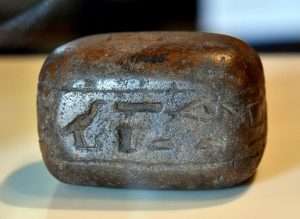
Stone_inscribed_with_the_name_of_Senenmut_from_Thebes_Egypt. ''Tomb of the Valley.''?
Gurdjieffs individual ''I's'' to enlarge.
''We learn only through a long process - a long journey. This is how we are 'converted' and freed.'' [Same].
Refresher: "Error runs down a plain, while truth has to...?"
''These are terms students may encounter while doing further research on the planets in the solar system: Jovian planets: The outer planets of our solar system: Jupiter, Saturn, Uranus, and Neptune....A planet designated as Jovian is hence a gas giant, composed primarily of hydrogen and helium gas with varying degrees of heavier elements. In addition to having large systems of moons, these planets each have their own ring systems as well.''
And/or: "Old illuminated manuscripts added a venerable river god lying on the surface of the stream, with Urn, aquatic plants, and rows of stars; for all of which the Hyginus of 1488 substitutes the figure of a nude woman, with stars lining the lower bank. Bayers illustration is quite artistic, with reeds and sedge on the margins.
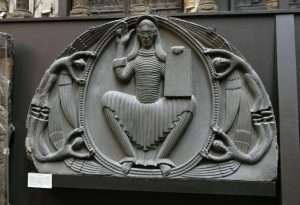
Blank?
The 'monster' Cetus often depicted with his fore paws, or flippers in the River." ['Star Names and Their Meaning' under Eridanus].
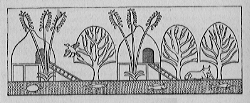
Reed huts?
Side note: ''Napoleon did not expect to be buried on Saint Helena, but in case that he was, his request was to "have me buried in the shade of the willows where I used to rest on the way to see you at Hutt’s Gate, near the fountain where they go to fetch my water every day".[3] He was buried with full military honours as a general. The full British garrison of 3,000 men lined the route of the cortège, with arms reversed. French General Tristan de Montholon requested that the tomb be engraved simply with "NAPOLEON" and his dates of birth and death, but the Governor, Sir Hudson Lowe, refused and insisted that "Bonaparte" be added. As a result of the impasse, the tomb slab was left blank.''
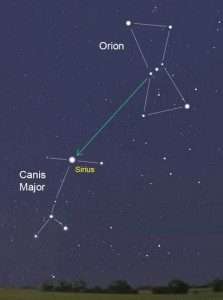 Continued..."The creative principle is the ideal phallus; the created principle is the formal cteis, {'womb' link}. The insertion of the vertical phallus into the horizontal cteis forms the stauros of the Gnostics, or the philosophical cross of the Masons. Thus the intersection [ 'crossover' point. This readers input] of the two produces four, which by its movement, defines the circle with all the degrees thereof." [Taken from the chapter entitled 'The Pillars of the Temple' from the book 'Transcendental Magic' by E. Levi. Emphasis, this readers]. Analogy using same principles but within a different time frame. From a different viewpoint, ['angle' symbolism], i.e.,''in profile'' as opposed to ''face on'' [Egyptian equivalent]. Don't forget those first impressions...i.e.,
Continued..."The creative principle is the ideal phallus; the created principle is the formal cteis, {'womb' link}. The insertion of the vertical phallus into the horizontal cteis forms the stauros of the Gnostics, or the philosophical cross of the Masons. Thus the intersection [ 'crossover' point. This readers input] of the two produces four, which by its movement, defines the circle with all the degrees thereof." [Taken from the chapter entitled 'The Pillars of the Temple' from the book 'Transcendental Magic' by E. Levi. Emphasis, this readers]. Analogy using same principles but within a different time frame. From a different viewpoint, ['angle' symbolism], i.e.,''in profile'' as opposed to ''face on'' [Egyptian equivalent]. Don't forget those first impressions...i.e.,
